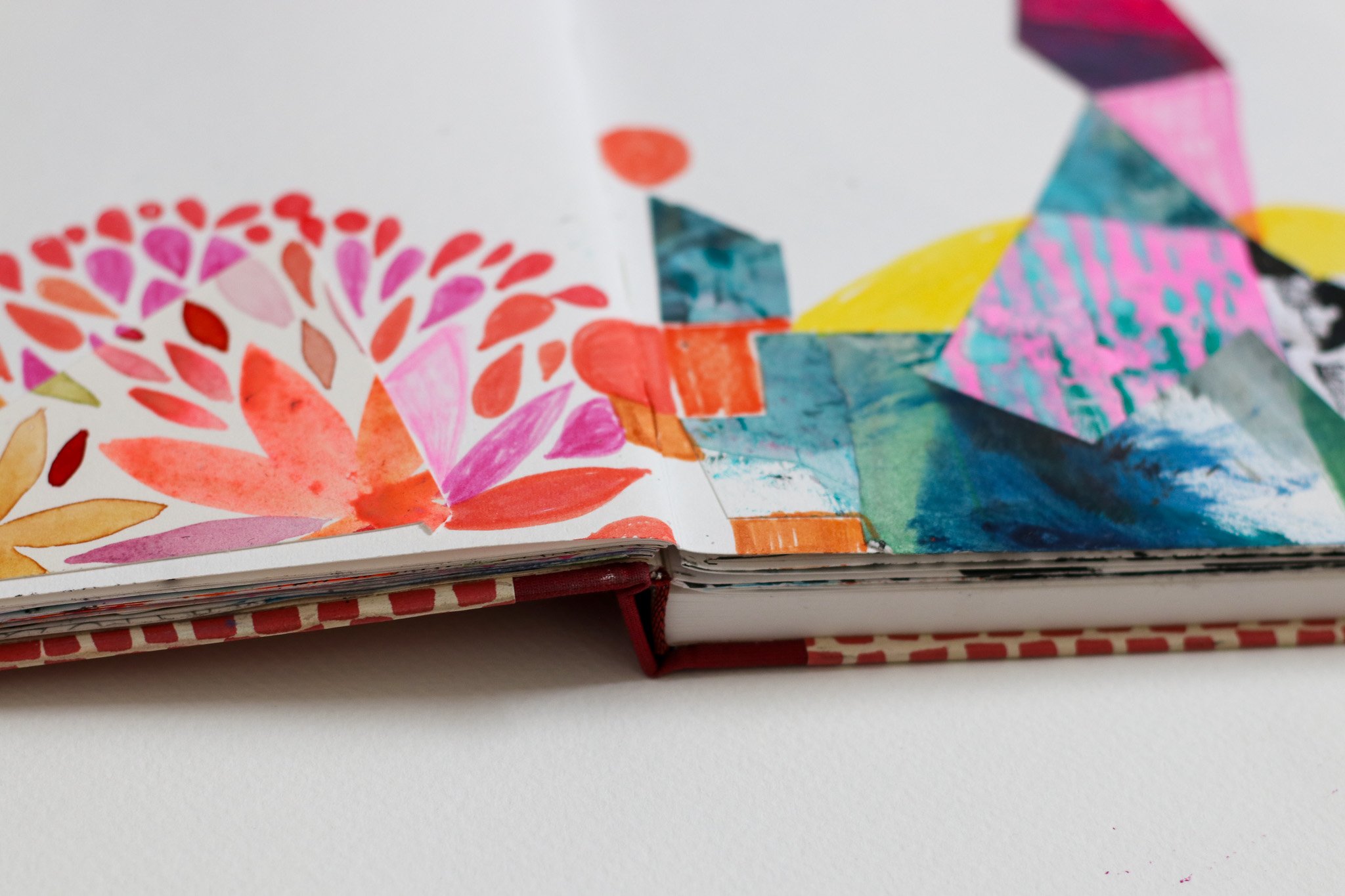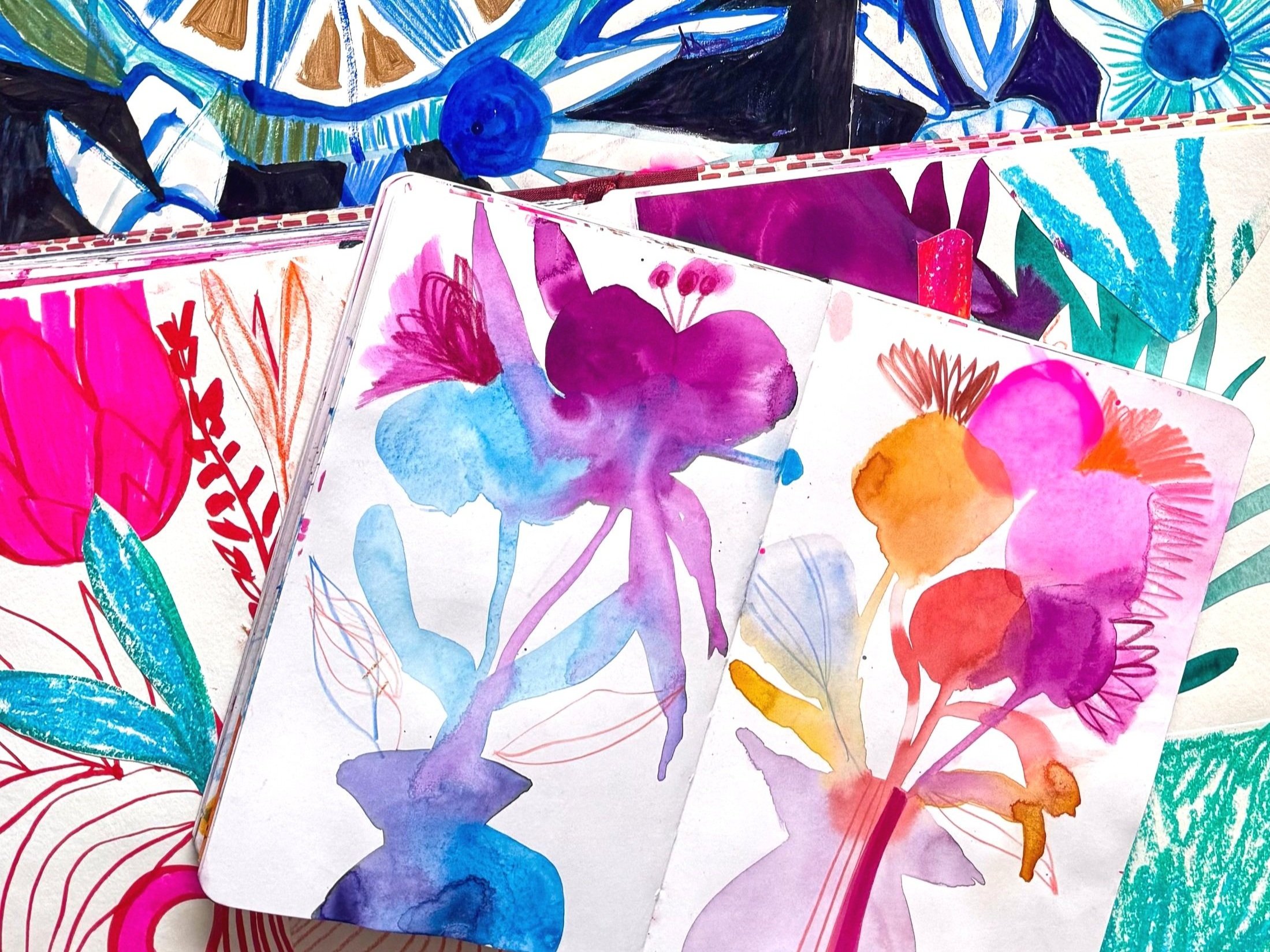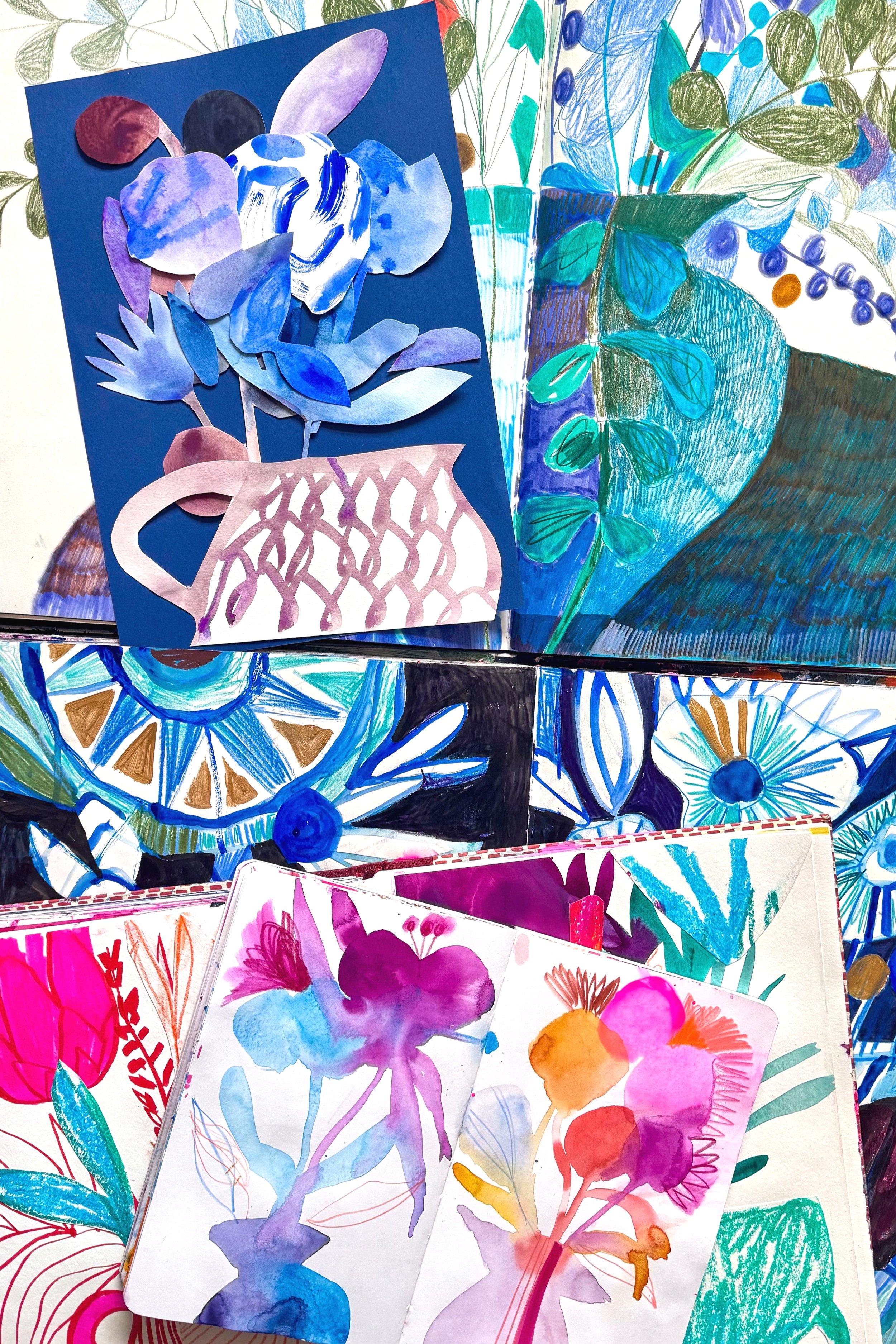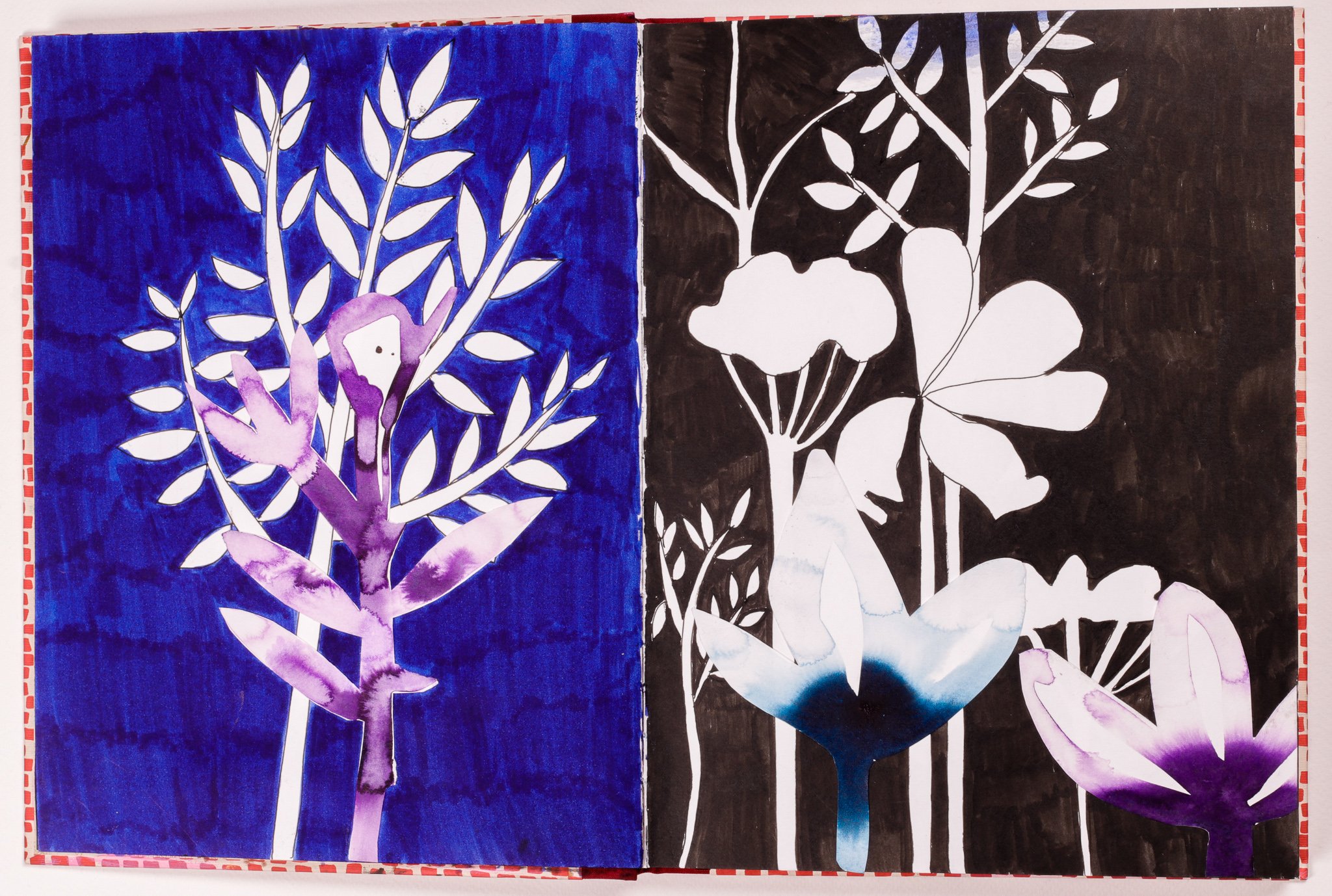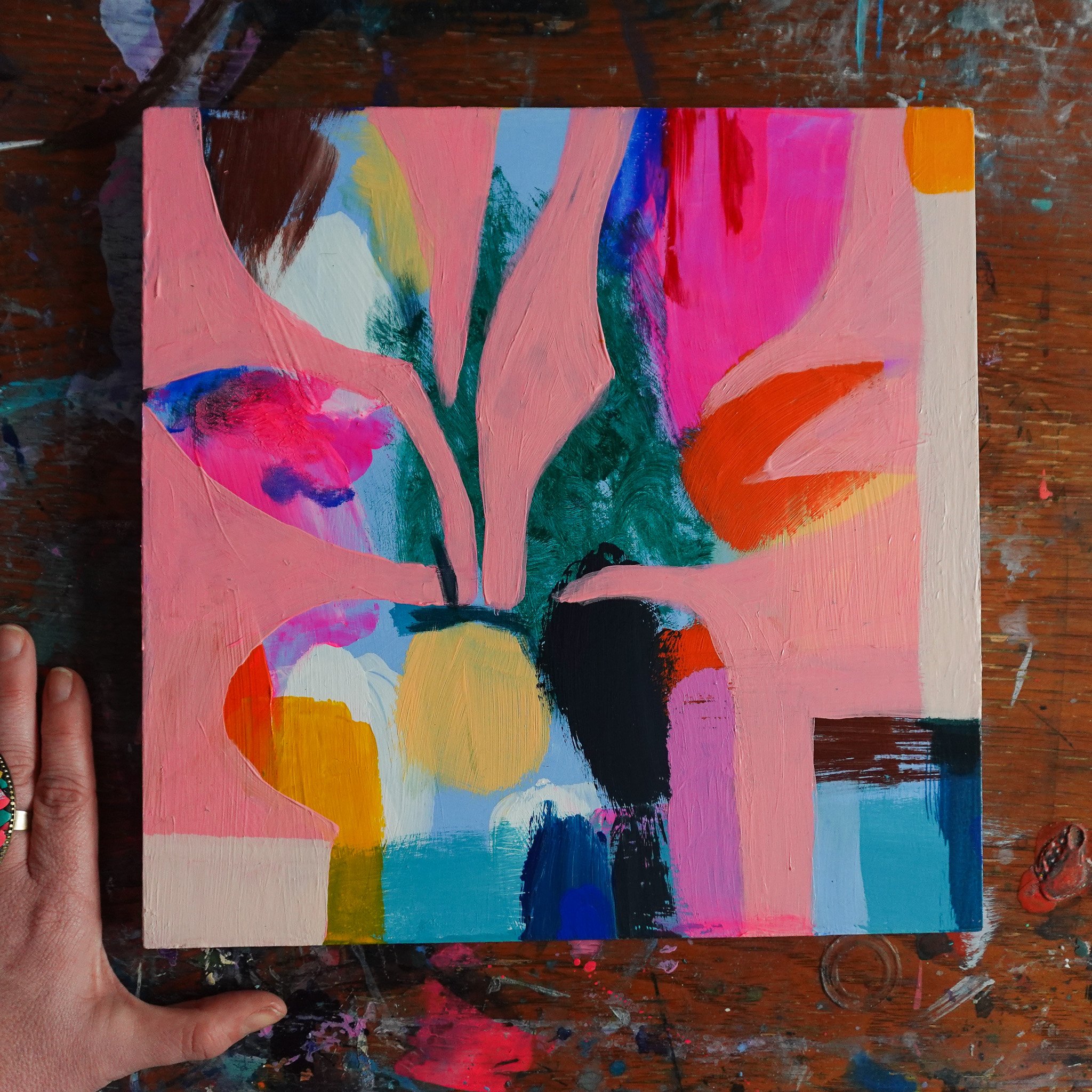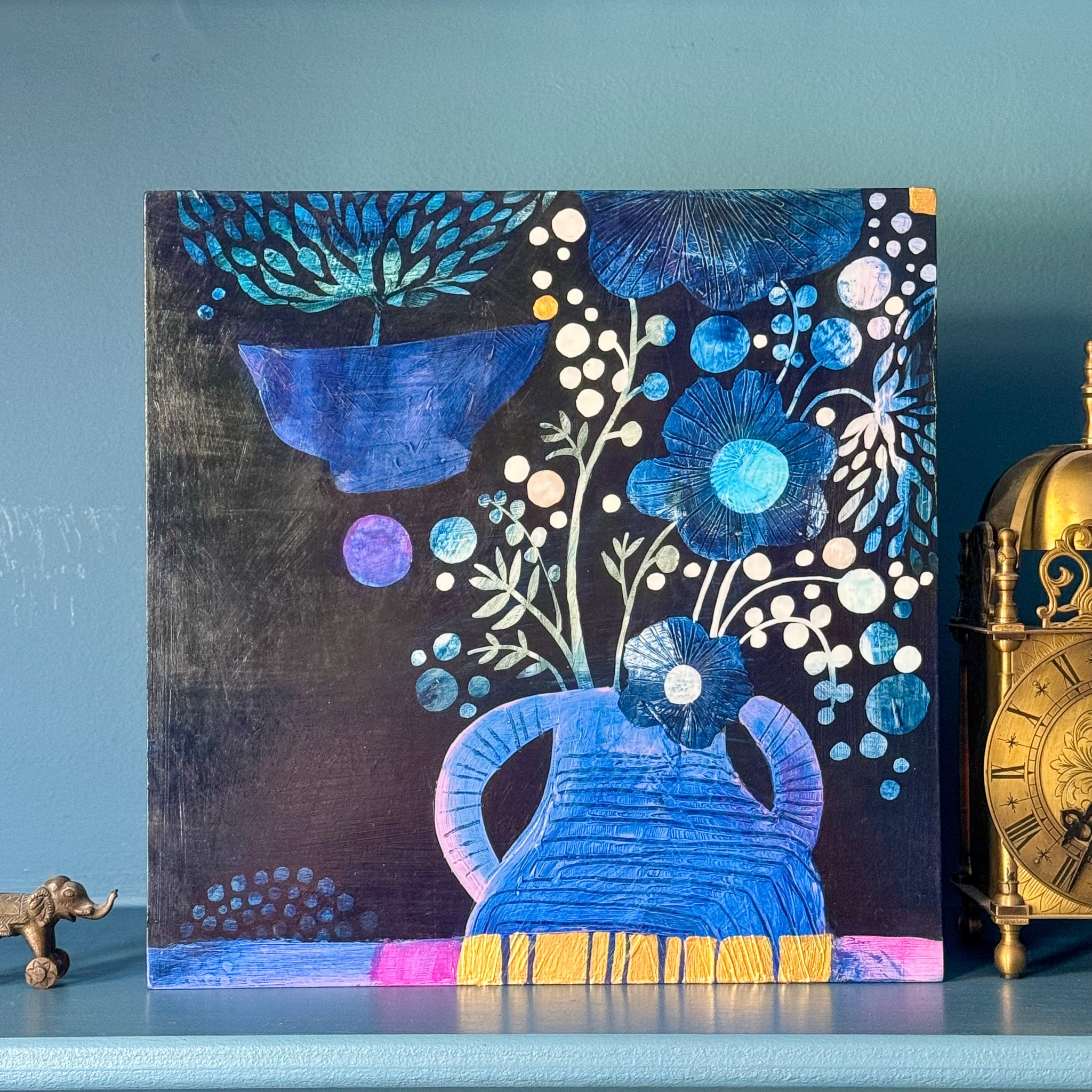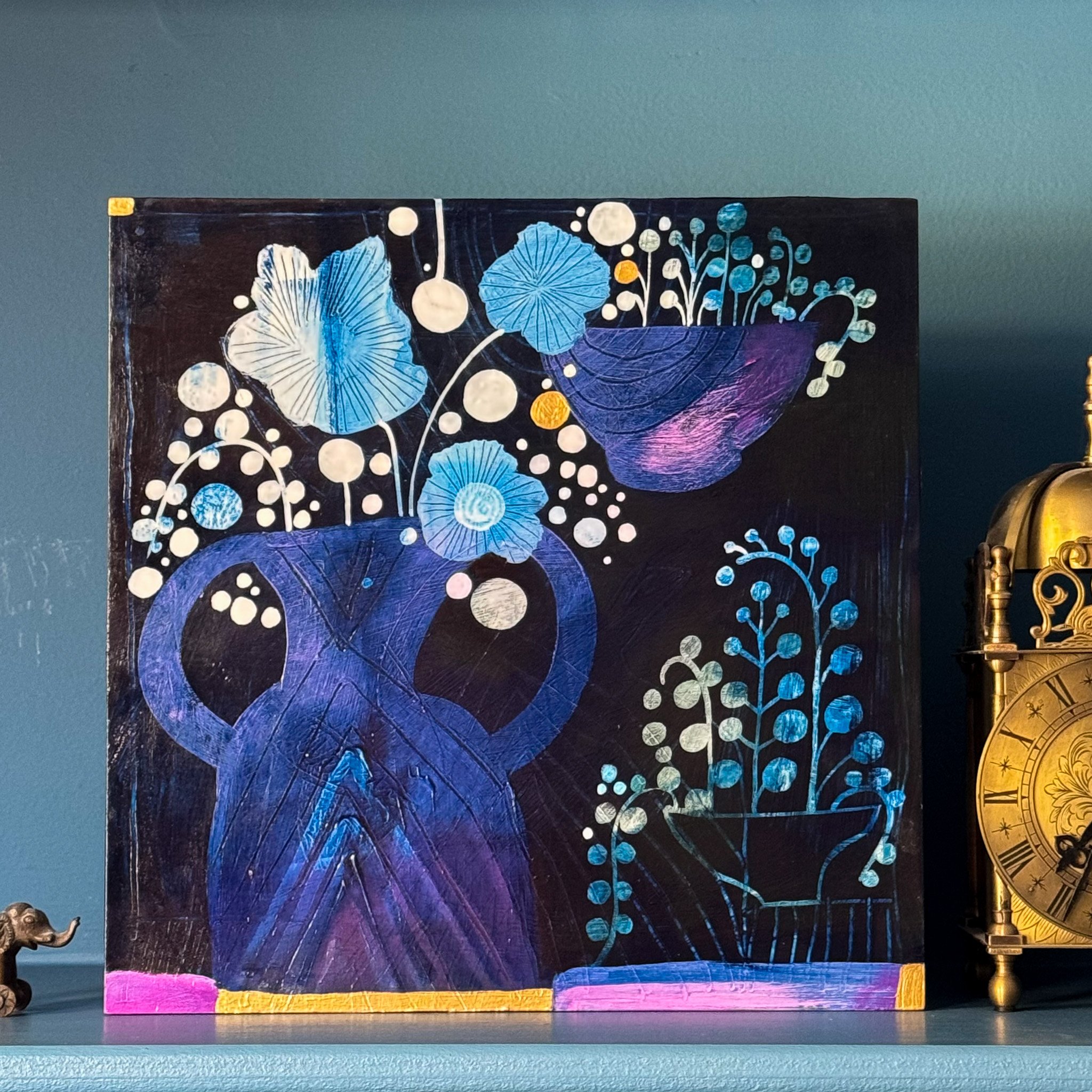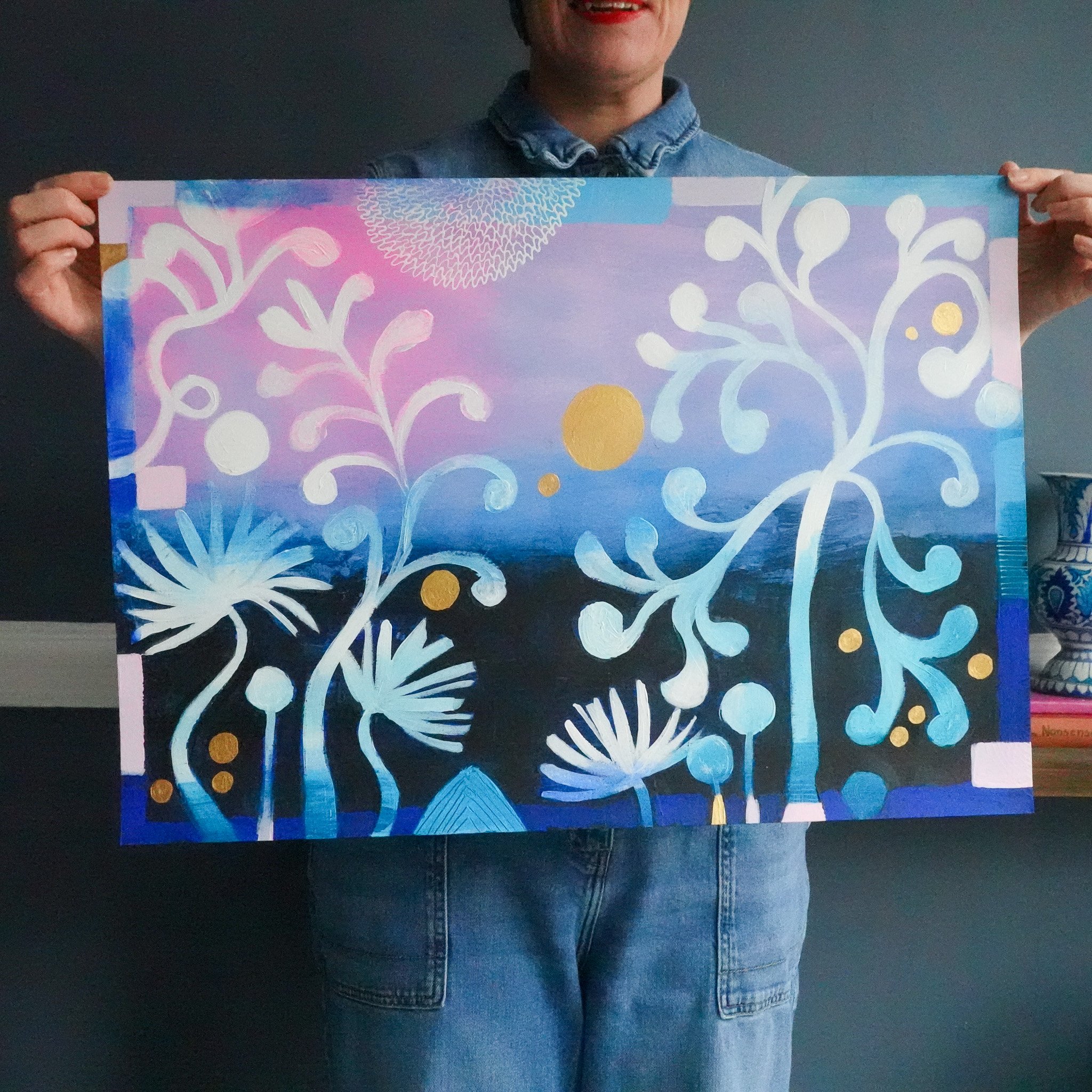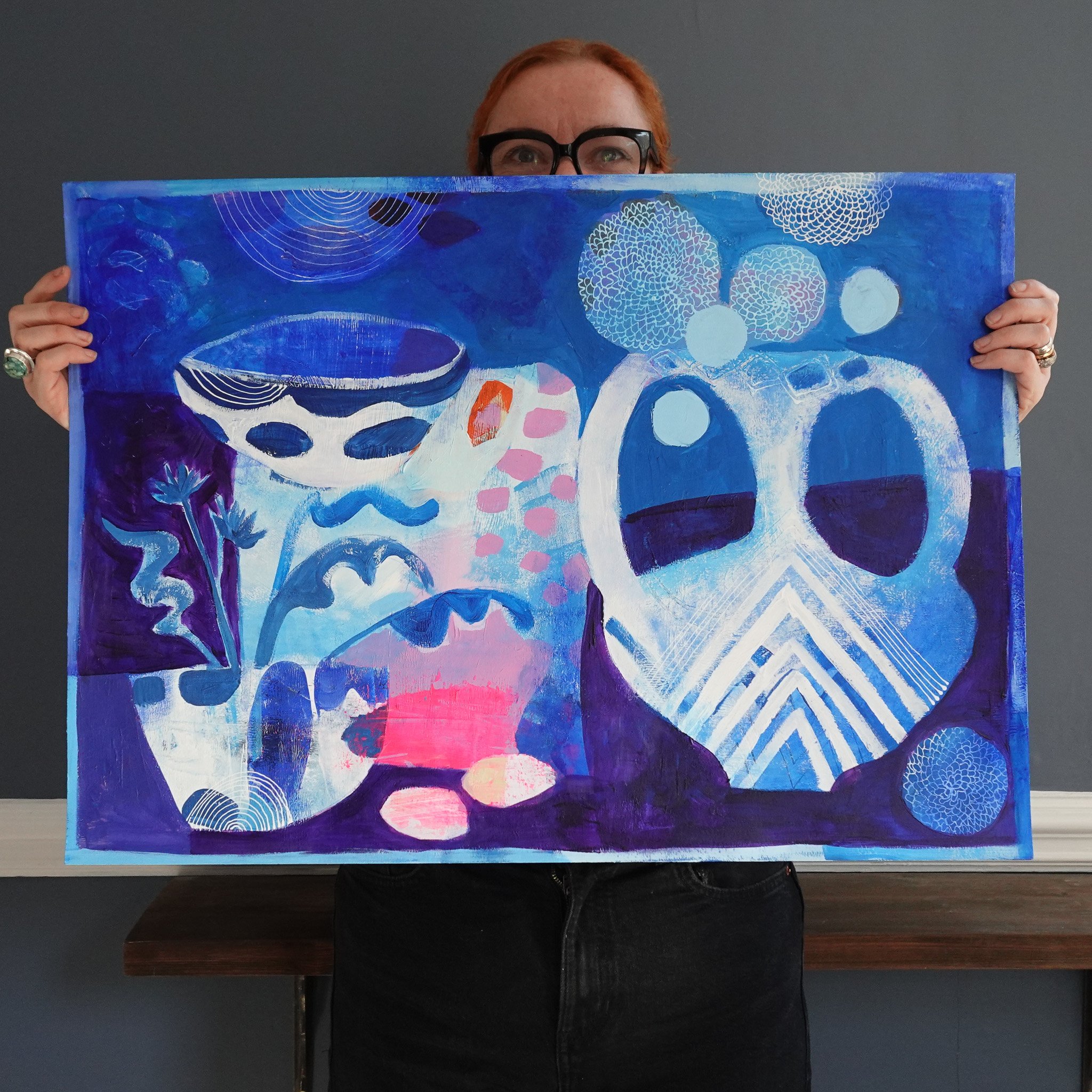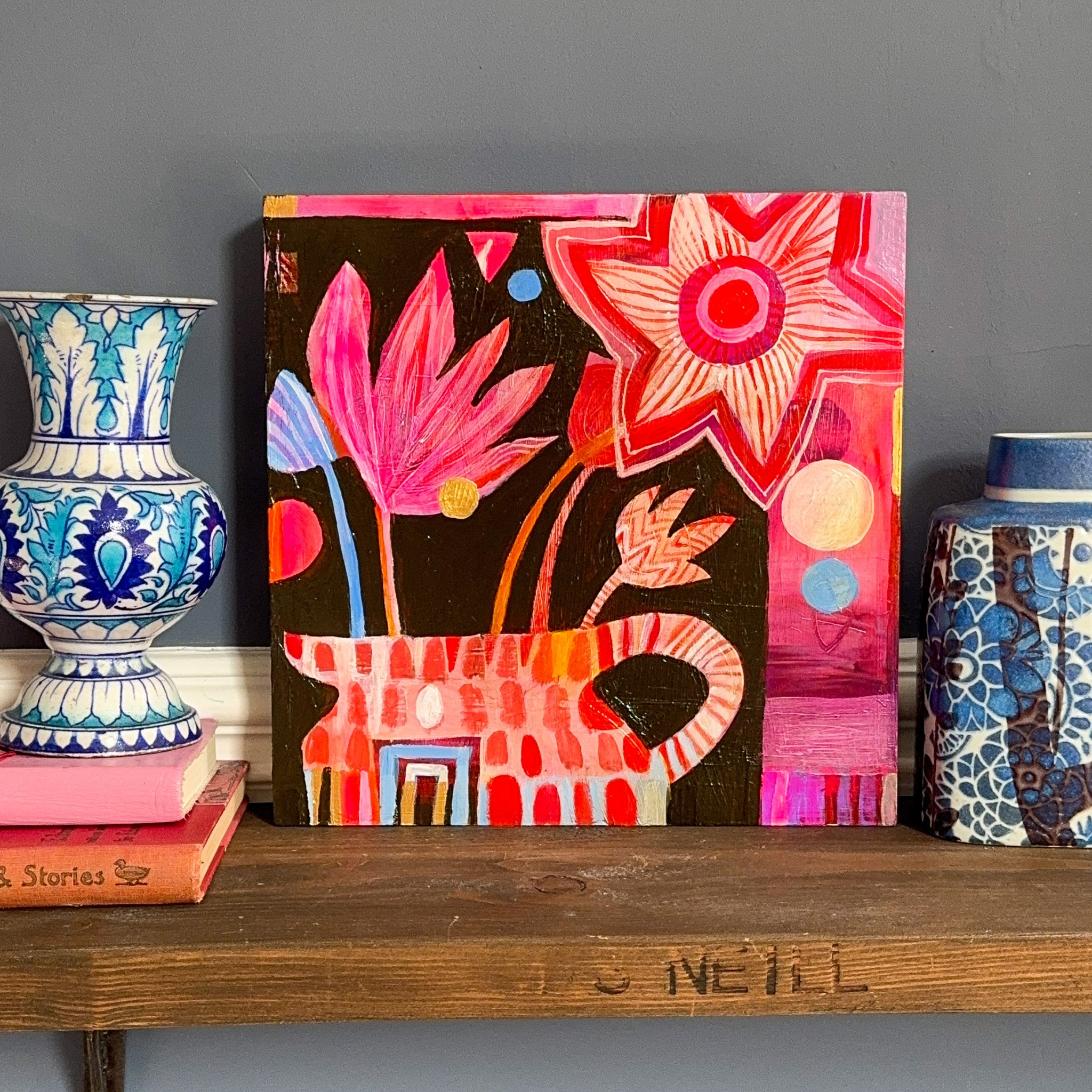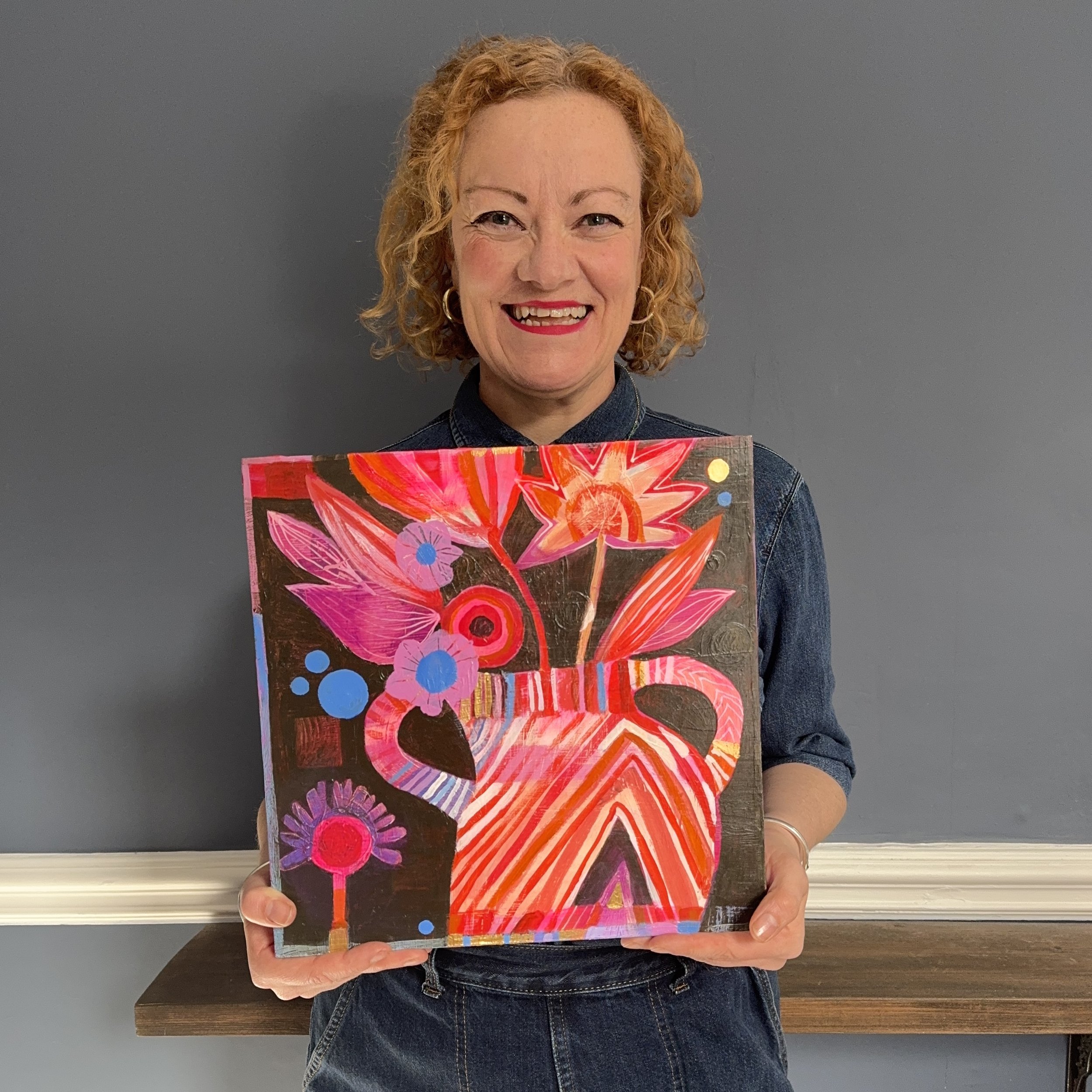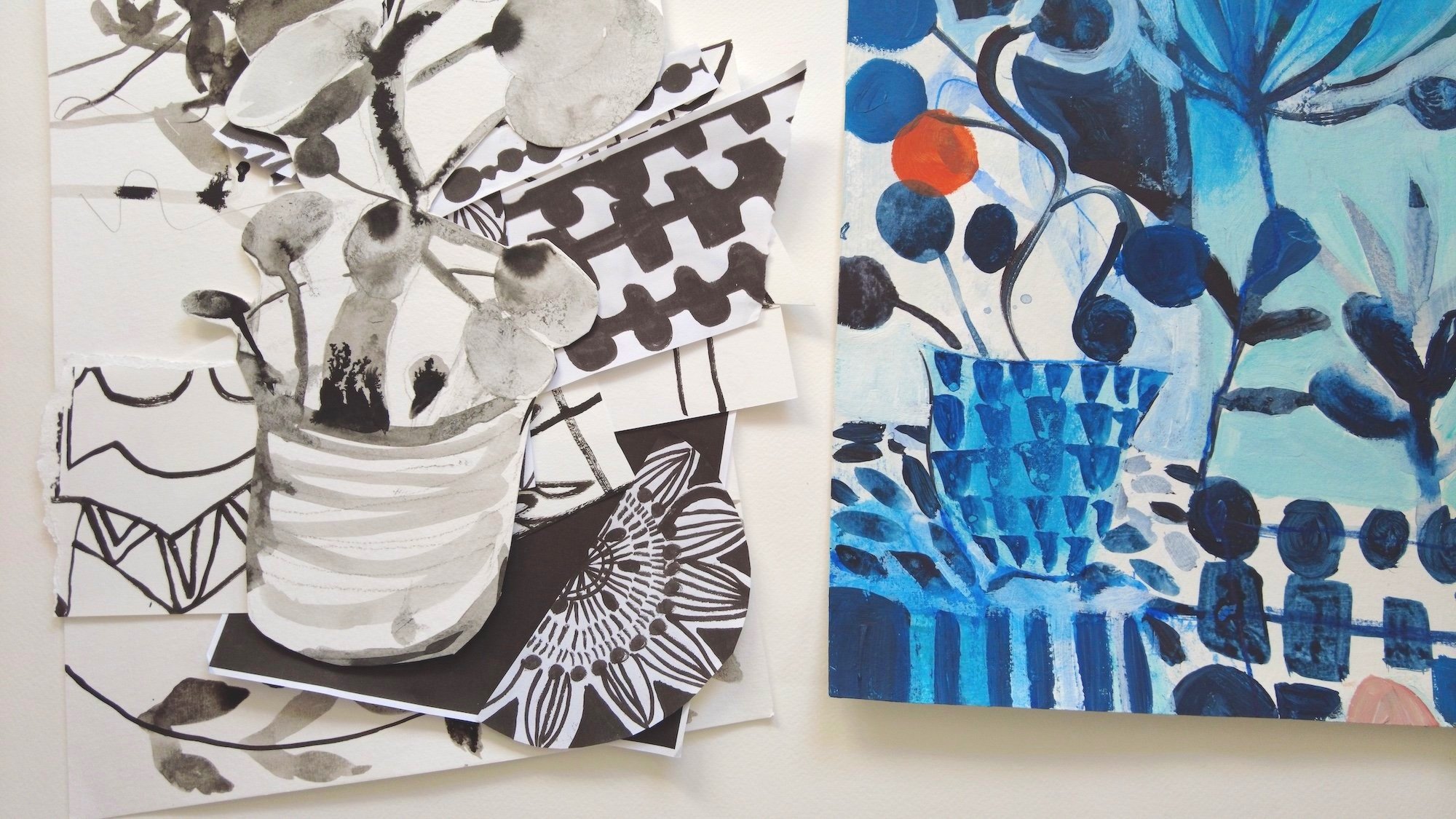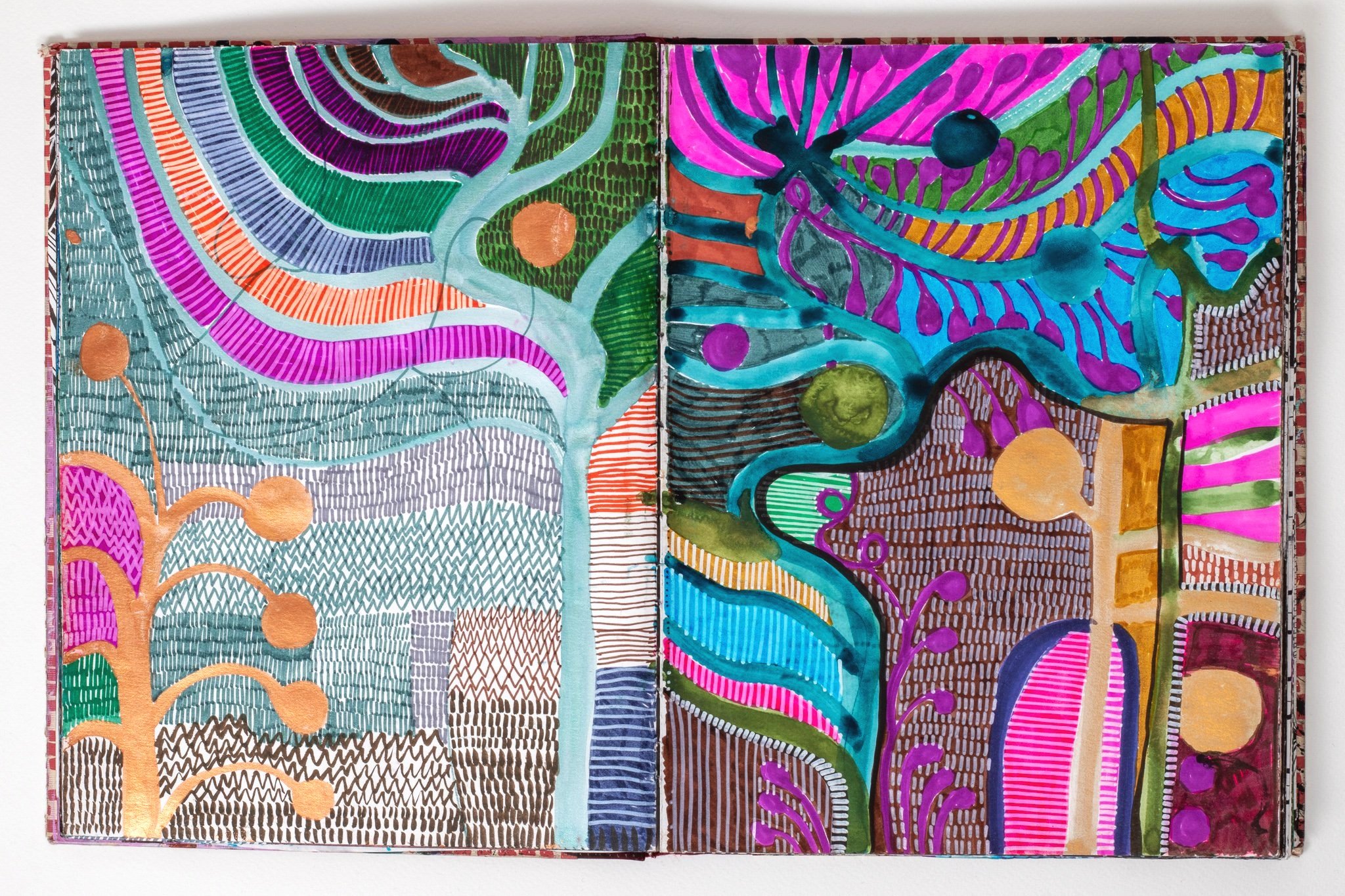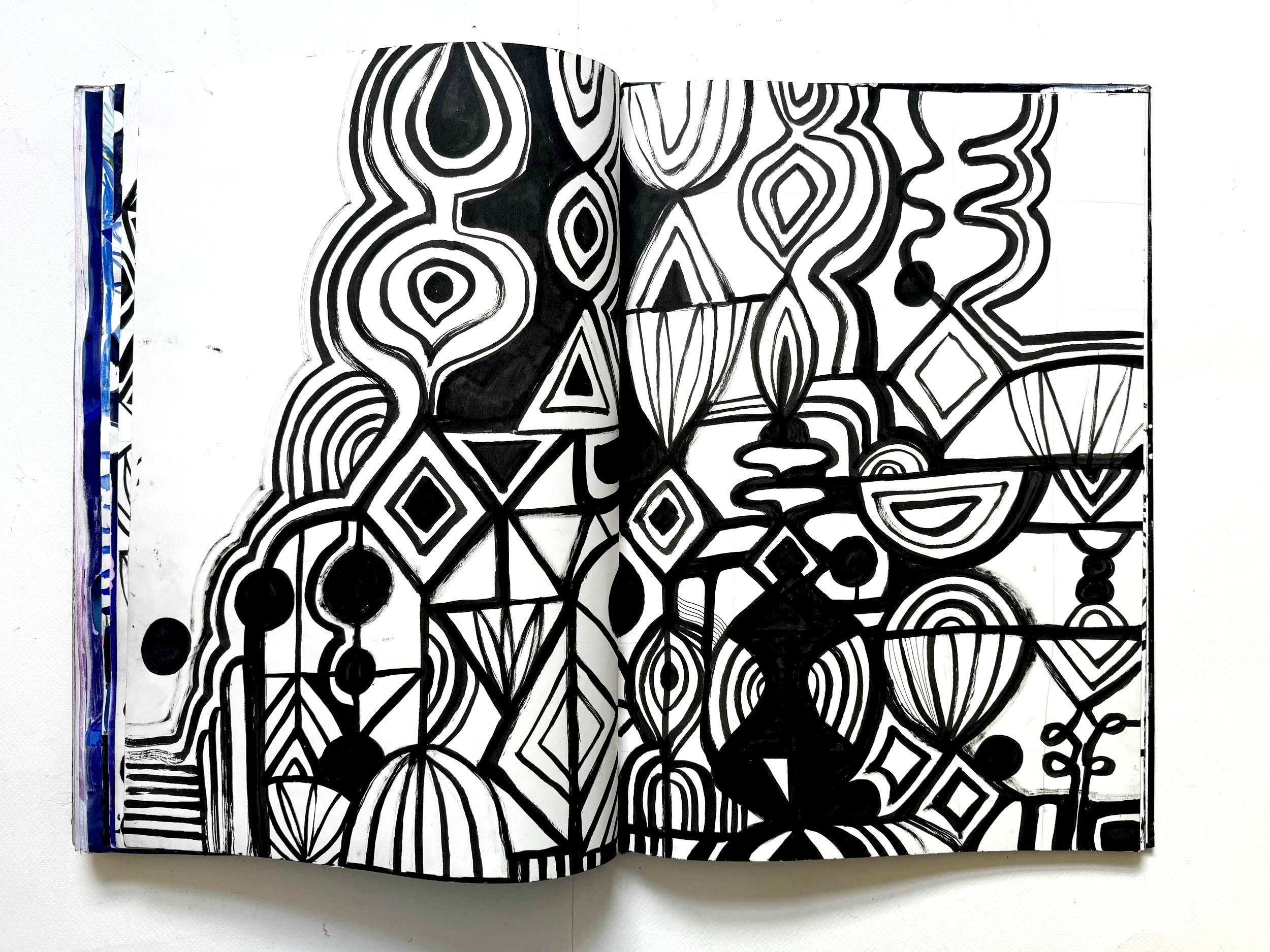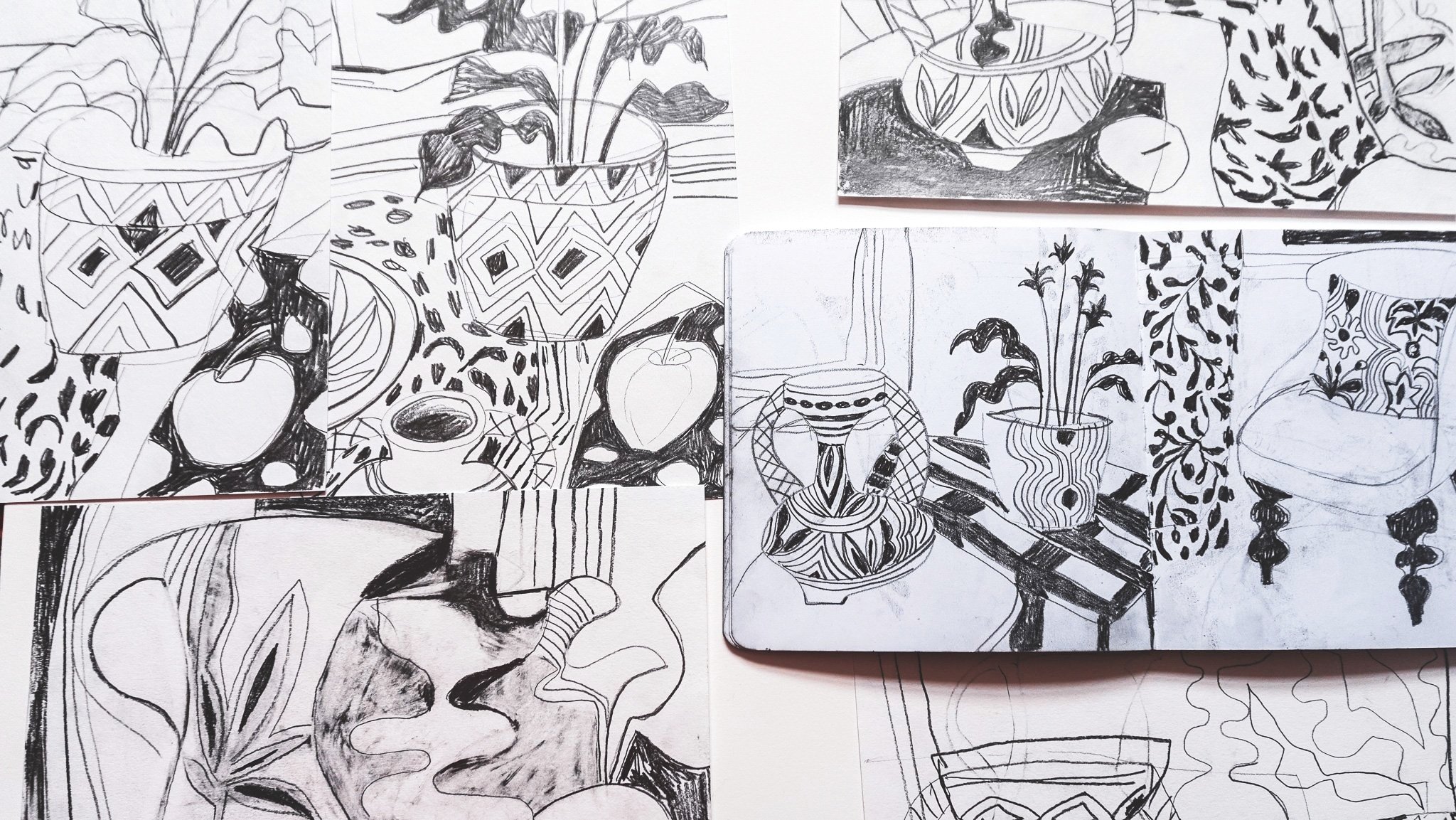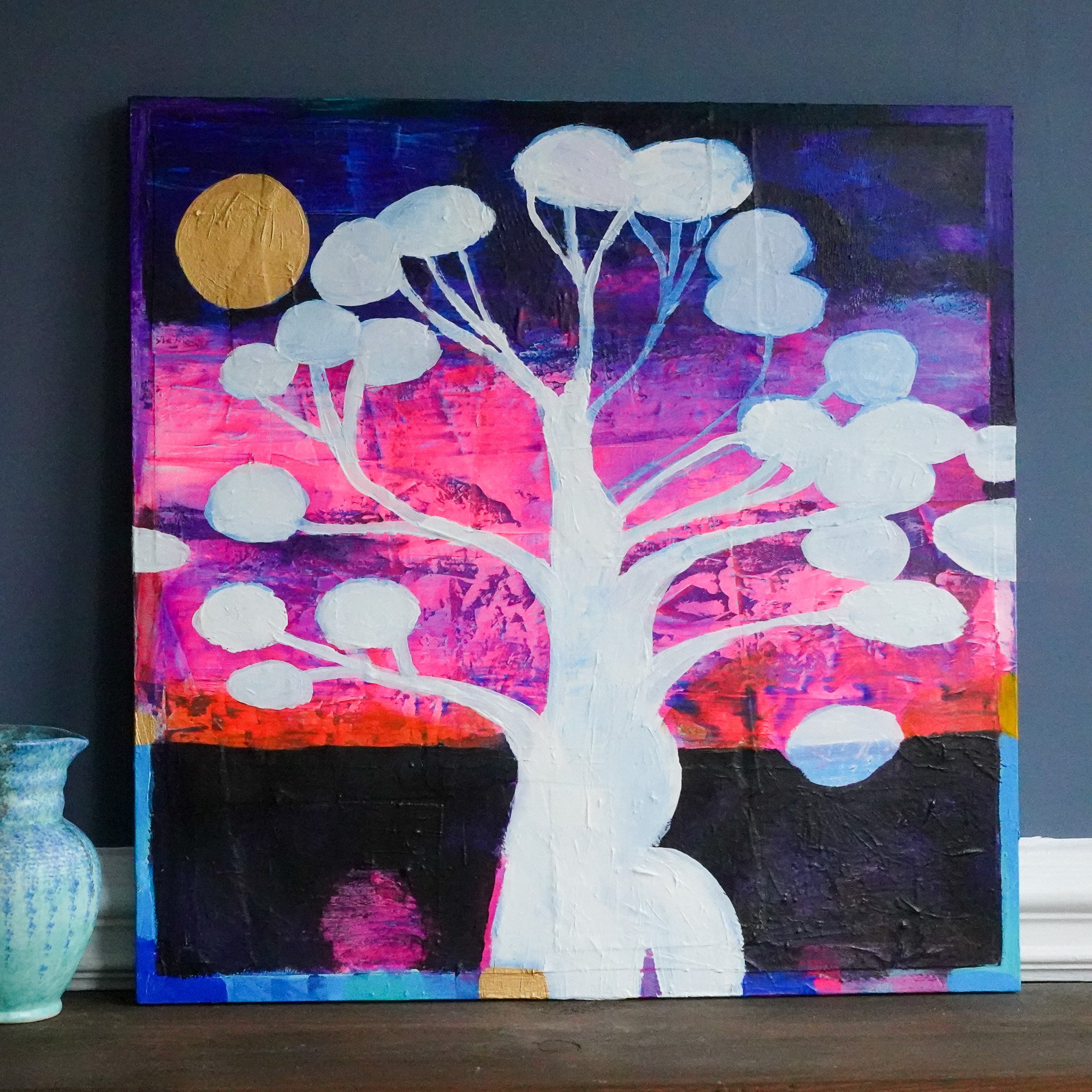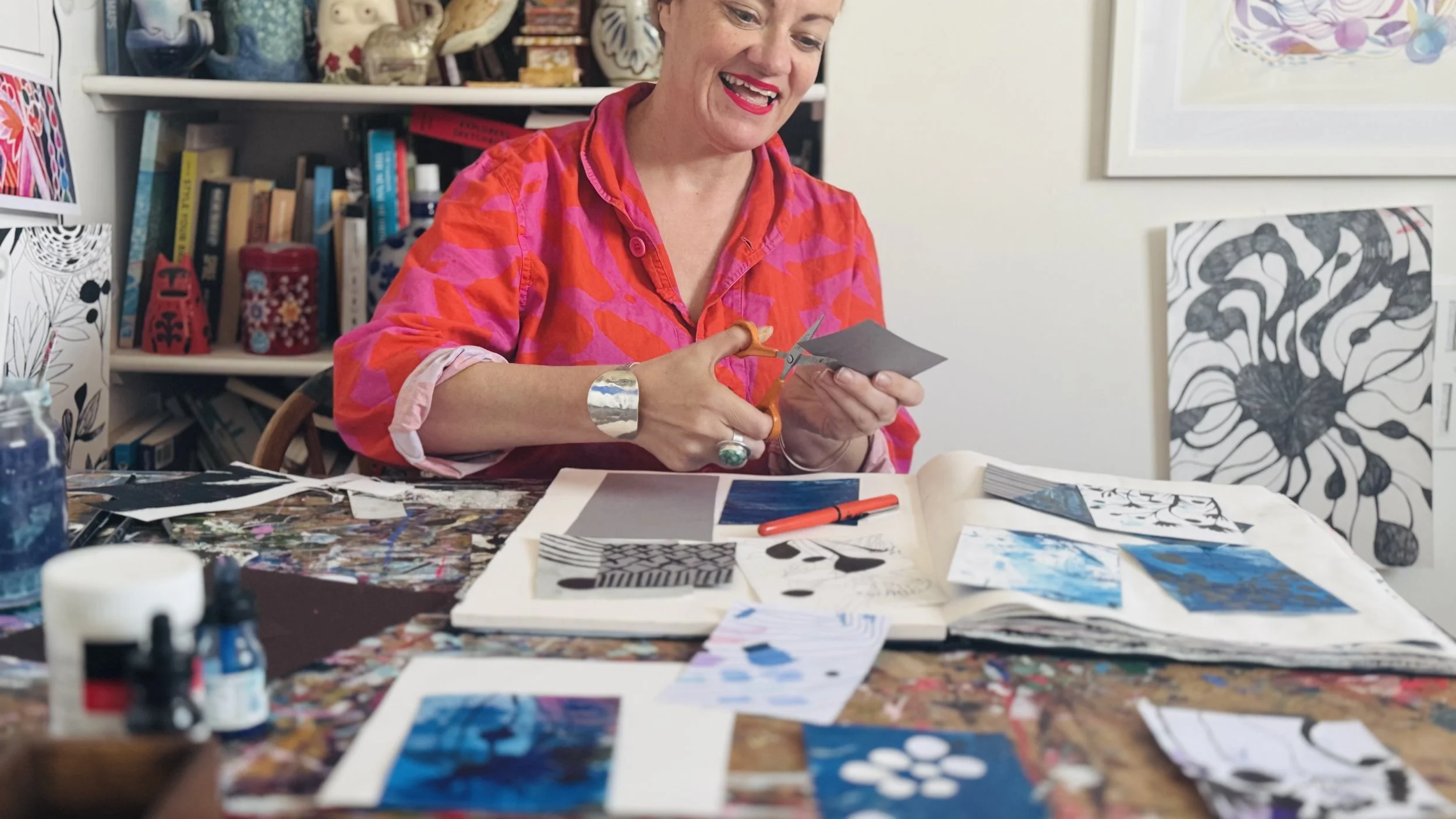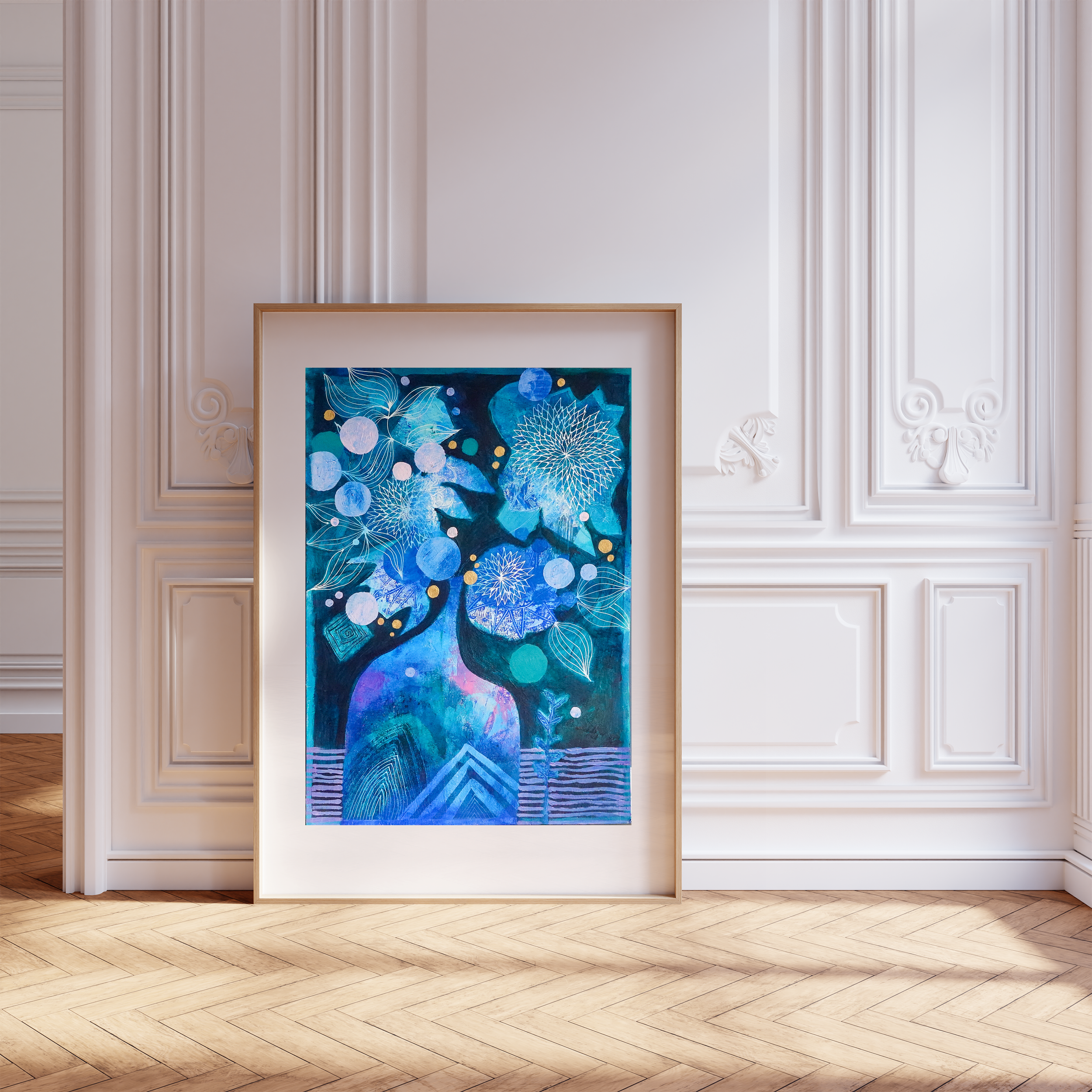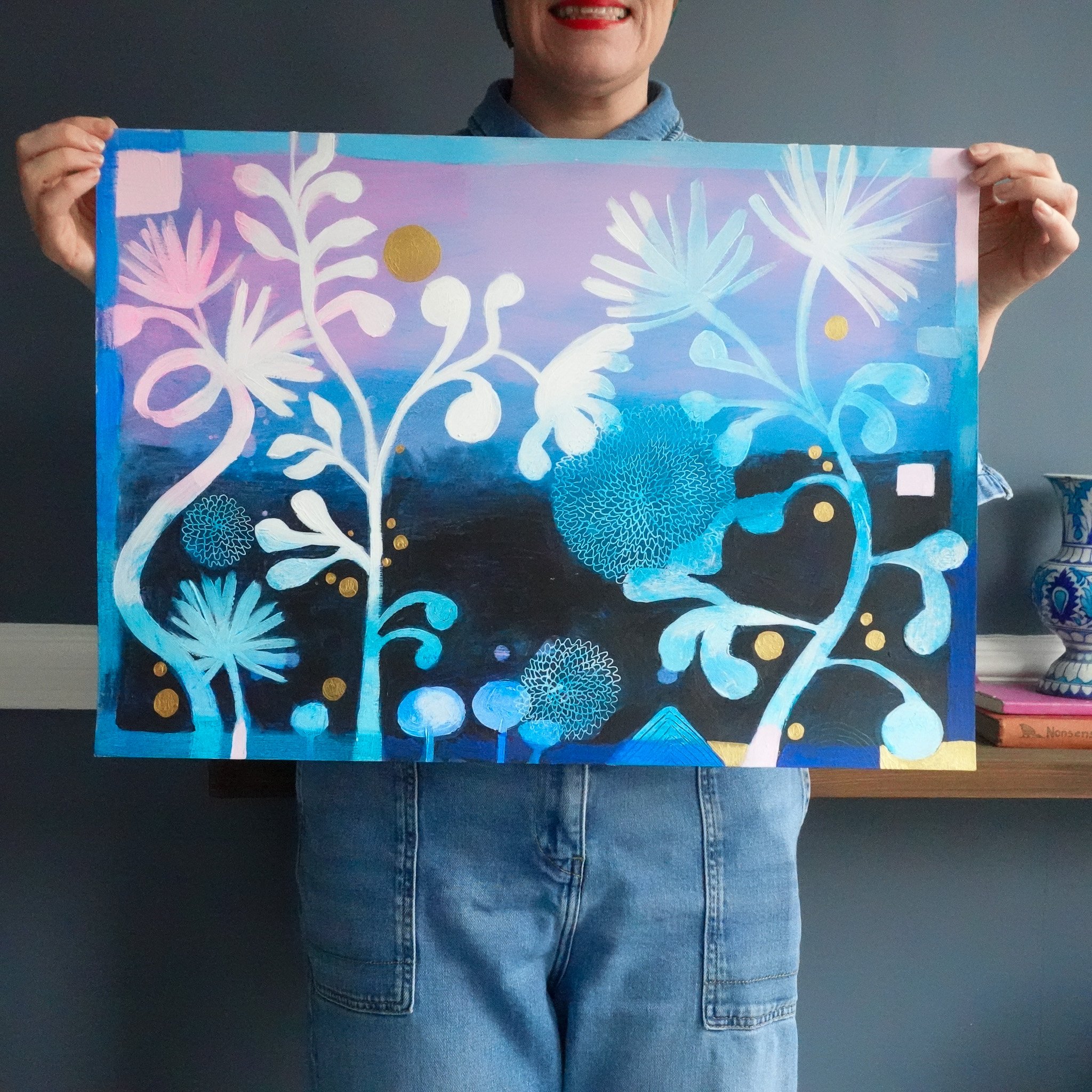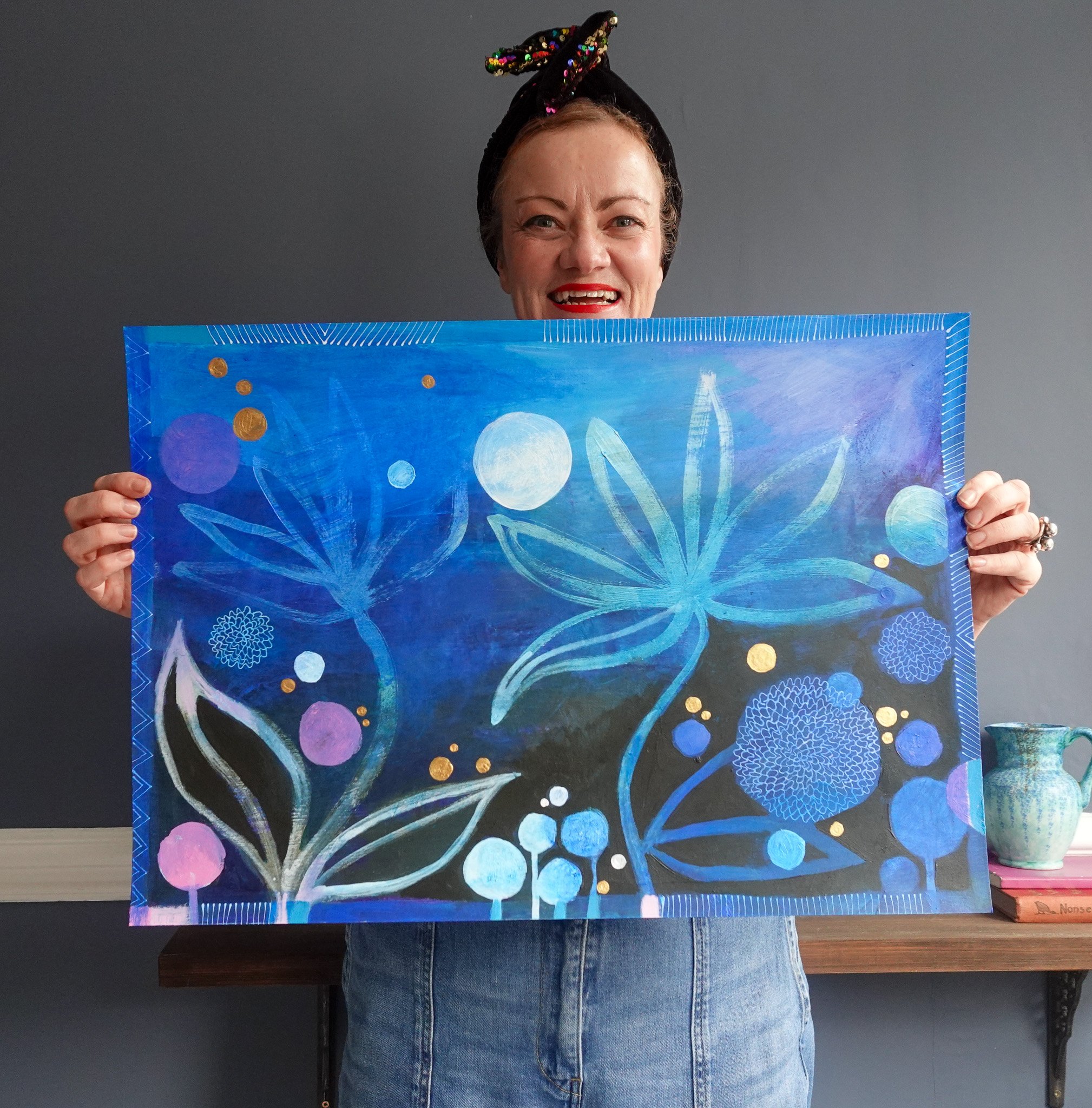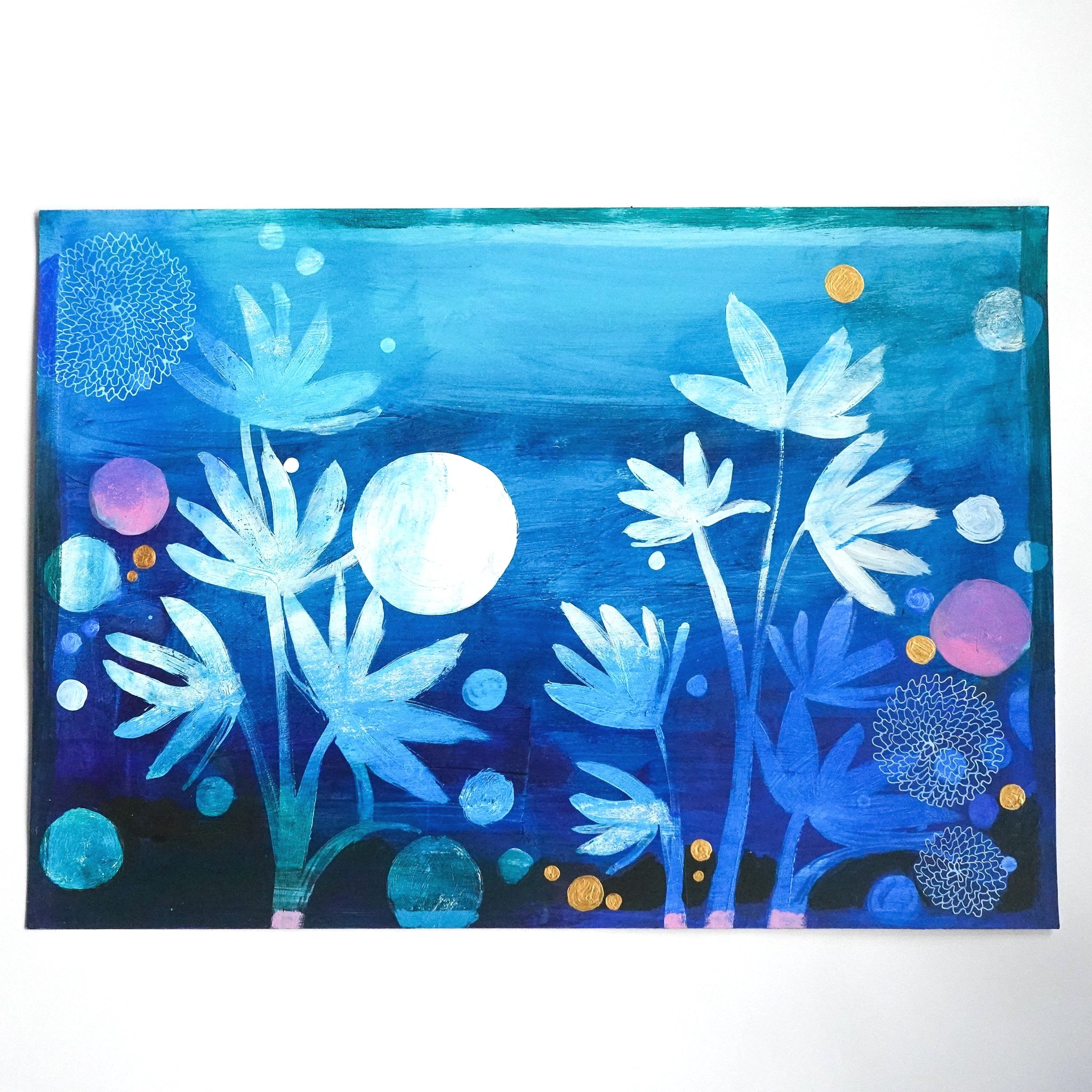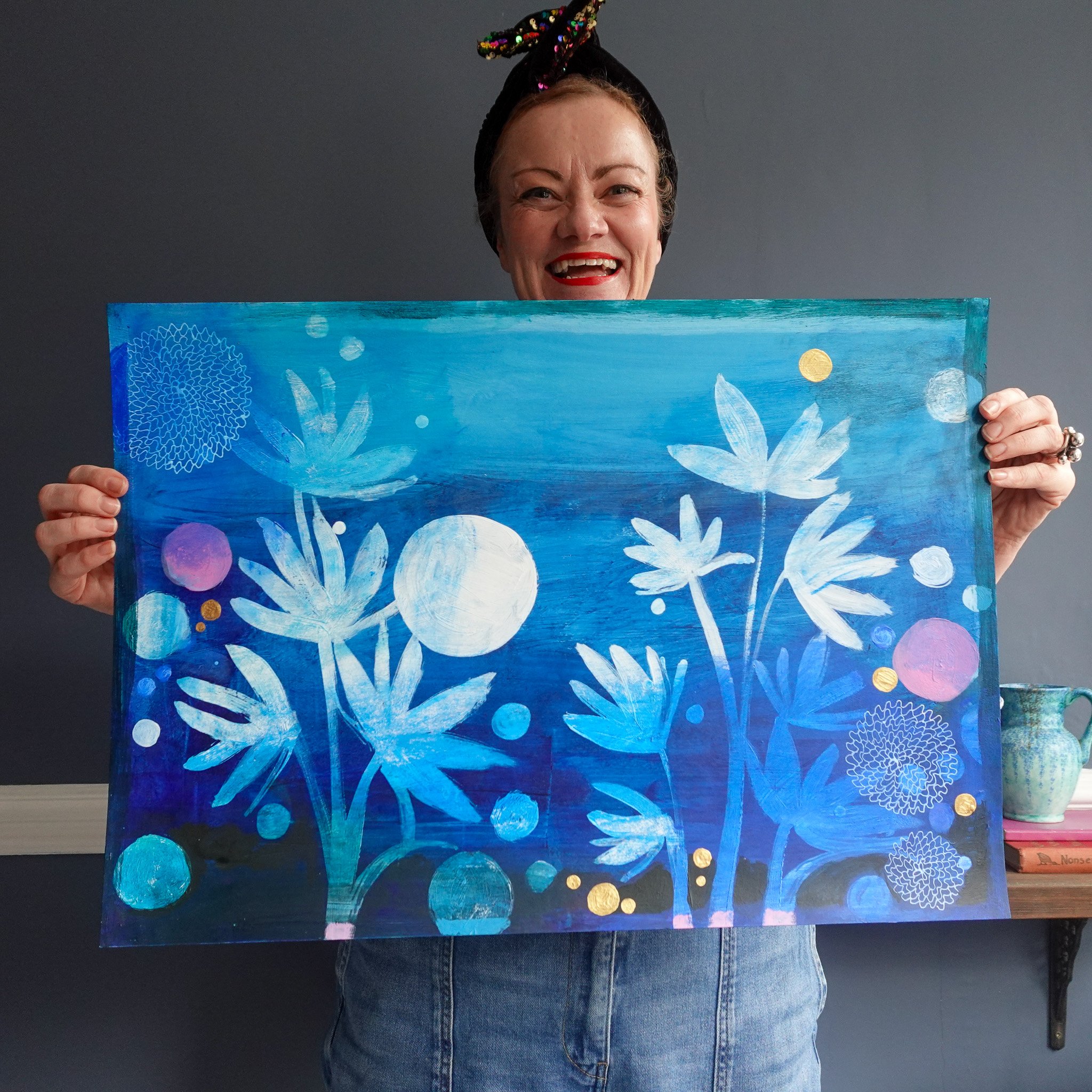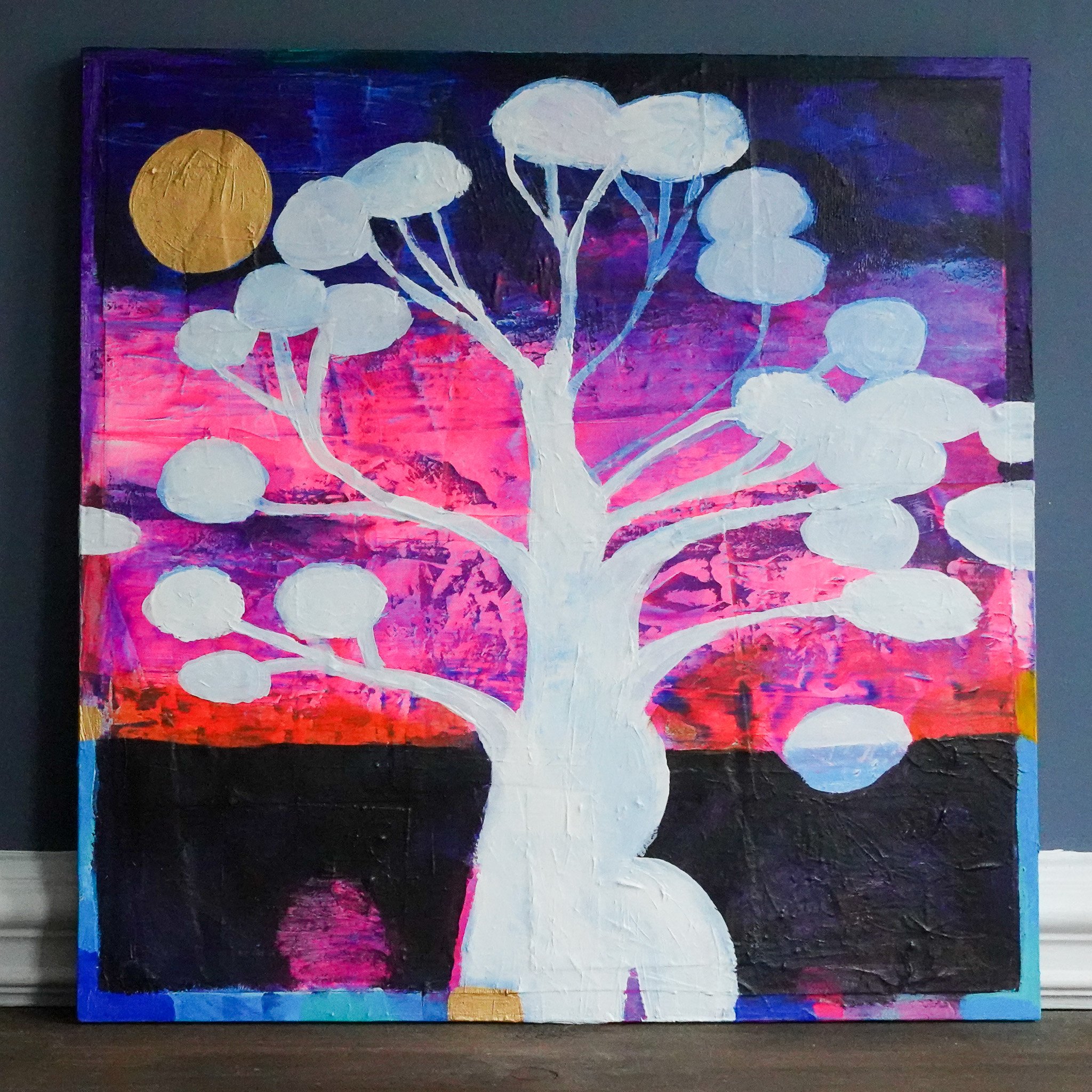
Art making ideasi
Ideas. Inspiration. A little creative mischief.
If you’re drawn to abstract and semi-abstract art, sketchbooks, colour and a little creative mischief, this is your corner of the internet.
In my blog you’ll find stories, videos, inspiration, and gentle nudges to help you create art that feels like you.
A sketchbook of fragments
Paintings, sketchbook ideas and art books…
This video for was filmed in December 2023
In this video I show you the progression of some abstract paintings, I take you inside a couple of my sketchbooks and share a specific approach I sometimes use to start and fill a sketchbook….I also share a few books I’m currently inspired by.
If you ever find yourself with an assortment of paper scraps, abandoned sketches, old art excercies or leftover bits from other projects you may like to try this. Instead of letting them pile up or throwing them away, turn them into a creative and joyful sketchbook practice.
I call this my Sketchbook of Lost and Lonely Fragments, it’s a low-pressure, intuitive way to explore composition, color, and mark-making.
Getting started
Collect scraps of paper, painted off-cuts, patterns, abandoned doodles, or any interesting textures and colors that speak to you. These could be anything from torn magazine pages to leftover swatches of paint on a palette.
Randomly glue them in to your sketchbook. Try not to overthink this bit, start adhering these fragments across the pages of your sketchbook.
Use the whole sketchbook. Work through your entire book, placing snippets on each page. This disrupts the intimidating blank page and provides a playful starting point for future creativity.
Developing the pages
Once your base of fragments is in place, you can revisit the pages at random and begin developing them further:
Explore intuitive mark-making. Use pens, pencils, markers, or paint to add details. Try drawing lines, shapes, patterns, or shading to interact with the fragments.
Experiment with composition. Let the placement of your scraps guide your creative choices. Try and create a balanced page by emphasising certain areas, using colors and exploring contrasts.
Play with different materials. Collage, stitch, paint, or even cut through pages to create unexpected layers.
Let surprises happen. Approach the process without a fixed outcome in mind. The goal is to stay playful and see what emerges naturally.
Why you many like to try this approach
It reduces the pressure of perfect. By starting with an already ‘disrupted’ page, you bypass the fear of the blank page.
It encourages playfulness. The randomness of the fragments leads to spontaneous and surprising compositions.
It fosters creative exploration. Working in this way encourages new ideas, unexpected juxtapositions, and unusual combinations.
Turns scraps into treasure. Re-use your abandoned art experiments. What was perhaps discarded now becomes an integral part of a creative process.
I think creating in this way is an invitation to embrace imperfection and spontaneity. It’s a reminder that art doesn’t need to be pre-planned or polished—sometimes, the most exciting discoveries come from embracing the unknown and unexpected.
So consider this a small invitation to gather your scraps, open your sketchbook, and start creating.
Books and links
Mark Hearld Workbook published by Merrell 2012, words by Simon Martin. You can follow Mark on instagram
Picasso on Paper, a catalogue from the The Royal Academy of Arts 2020, to accompany the exhibition of the same name. There is a Youtube video of the exhibition here
Brian Wildsmith, 123 first published in 1965, by Brooklyn Art Books for Children. There is a website cataloguing Brian’s books, art and illustration here or there is an instagram account managed by his family
The two sketchbooks I show is this video are 1. The Venezia Book from Fabriano and 2. A3 Ebony Artist Sketchbook from Daler Rowney.
Balancing chaos and focus in art making
Here I share some thoughts on how creativity works…
Creativity often swings between inspiration gathering and disciplined execution. At the start of any creative endeavor, we might need a little chaos—openness, curiosity, and exploration. But to bring an idea to life, we need the opposite: clarity, focus, and determination.
Sometimes, we need the scattergun. Sometimes, we need the laser.
As I write this, I’m in the thick of filming my next online course. The process of creating this course has made me reflect on how creativity often demands two distinct modes: exploration and execution.
For the past two months, I’ve been in the scattergun phase—of coming up with ideas, hunting, gathering, experimenting, and throwing ideas at the wall to see what sticks. I’ve been absorbing books, discovering new artists, writing notes, journalling, sketching, expanding different techniques, and letting curiosity lead the way. This stage thrives on novelty, variety, and stimulation. It’s a time for playful chaos—inviting in fresh ideas, mixing influences, and allowing creative sparks to ignite.
But now, I’m in the laser phase—actually turning the ideas into a reality. Taking all the threads and creating the thing. This requires a completely different mindset: deep focus, structure, and an ‘all-in’ mentality. The distractions that once sparked ideas now threaten progress. Instead of jumping between concepts and tasks, I must commit, push through challenges, and sustain intense concentration.
This dance between divergence and convergence happens in most creative endeavors. It happens when making art—we start with an open field of possibilities, then gradually we define a path, make firm decisions, and commit.
Navigating the two modes in art making:
Embrace the scattergun phase fully
At the start of a project or new body of work, embrace the ambiguity and uncertainty. There is often a lot of ‘not knowing’.
Experiment with different materials, colours, techniques, styles and subjects—invite in the ‘new’ or novel without pressure or expectation.
Seek inspiration from unexpected sources: museums, obscure books, nature, seek outside of your usual circles of reference...
Fill sketchbooks with unfiltered ideas—sketchbooks are often divergent thinking in action…lots of experimentation, gathering, connecting dots…
Follow your intuition. Let curiosity guide you. Resist the urge to make sense of everything immediately—connections and breakthroughs often emerge over time.
Give yourself the opportunity to rest and the space to think if you can; creative ideas often surface when the mind is relaxed. “I’ll sleep on it”…is a truism for a reason. Allowing a little spaciousness into our lives, is fertile, it can allow ideas to take shape and grow.
Gather inspiration like you’re building a virtual pinboard—often, magic happens in the weird combinations and unexpected connections.
Commit to the laser phase when it’s time
Finishing an artwork or any creative project often requires a real focus and concentration. Align deep work with your natural energy cycles—concentration flows best when you work with your own rhythms.
Set aside dedicated ‘studio’ time to refine, develop, and focus on your work. Set a timer for an set period of intense concentration and deep focus
Trust the instincts you developed in the exploration phase—this stage is about shaping, not second-guessing.
Reduce distractions (social media, external input) and fully immerse yourself in the process.
“Efforts to deepen your focus will struggle if you don’t simultaneously wean your mind from a dependence on distraction.”
― Cal Newport, Deep Work
Know when to switch gears
If your work feels chaotic and unfocused, it might be time to narrow in and commit to a single direction.
If you feel stuck or uninspired, loosen up—step away, explore new references, invite in something new or experiment freely again.
Creativity in art and life isn’t about choosing one approach over the other—it’s about learning to move between wild experimentation and disciplined refinement. The scattergun fills the well; the laser brings the vision to life. It seems to me that both are essential.
Sketchbooks: searching for beauty and treasure
Looking for treasure in old sketchbooks…
In this video and blog I take you with me as I hunt back through sketchbooks, some old, some more recent looking for inspiration and I chat about the importance of using the ‘beauty of what we love’ to guide our creativity.
I am looking back through my sketchbooks for several reasons:
To pick up lost threads and re-familiarise myself with what is calling to me within my own art after taking a break from creating
I am looking to see if there are any pages in my sketchbook which I particularly like, which are worth scanning and which could possibly work on a larger scale as wall art
I am also doing some thinking and preparation for an interview with FIDA worldwide about the importance of sketchbooks. You can read what I said in the finished interview here
Looking back through your own creations with an inquisitive heart is often a useful way to take stock. It helps that I have years and years of sketchbooks I know, but I think it can be a useful practice at any point in your creative journey...
Spending time carefully looking at and considering a pile of your own art creations can be an interesting exercise in connecting, noticing and getting specific about the things you love in your own work.
Our art work often reflects something of ourselves back to us…it can provide us with bread crumb trails and signals about the next path to take or the next thing to create.
Be a detective, seek and identify the specific moments in your own work which fascinate you the most as these could contain the clues that you need for which path to follow in your artistic investigation.
This year I have been drawn back to a line from a poem from Rumi the Sufi poet. “Let the beauty we love, be what we do.” It’s a philosophy that is so useful to bring to our art making and life if we can.
The full section of the poem is
Today, like every other day,
we wake up empty and frightened.
Don’t open the door to the study and begin reading.
Take down a musical instrument.
Let the beauty we love be what we do.
There are hundreds of ways to kneel and kiss the ground.
From Rumi: The Book of Love: Poems of Ecstasy and Longing, by Jalal al-Din Rumi, translated by Coleman Barks.
It strikes me that this is a powerful sentiment for now, when many of us wake up feeling empty and frightened by the things that are happening in the world.
It speaks of letting our own light shine, being truly ourselves, letting our own creativity galvanize us and lead the way, not letting other’s expectations of us get in the way of the things we love to do, the things we must do. That creativity is important.
It reminds us to listen to what is calling to us, if we are able to amongst the noise, to pay attention to what makes us feel alive, interested and curious, to create rather than consume.
It suggests that perhaps letting our own unique flavour of creativity flourish is a way to bring light, show gratitude, live well... That perhaps creativity can be considered an important act of devotion, gratitude, or rebellion...
So consider this a small reminder and rallying call to try to let the beauty of what you love, light your own path and let it be your own guide and mentor…
Creativity can be a balm for the soul
Creativity is a balm for the soul…
“A lot of people don’t feel creative because they’re physically and emotionally exhausted. The recipe for your life should be this: rest until you feel like playing, then play until you feel like resting, and then repeat.”
2025 has unfolded slowly for me. I’ve been poorly with something resembling flu and have spent much of this new year in my pyjamas coughing …
Pencil sketchbook pages from last year
I have done little in life or art, but now I am feeling a bit stronger I have spent some low-key, quiet time meandering in my sketchbook.
Playing with some simple drawing materials… Expecting very little of myself, creating as a lovely distraction. Manufacturing small moments of joy, just as a nice thing to do. Creating for the sake of creating, not for any outcome, just for the experience of doing it.
A sketchbook from a few years ago…
It has made me think about the healing nature of creativity and how beneficial my sketchbook practice has been to me through difficult passages of life.
The last five years have presented a small rollercoaster of personal challenges, as I’m sure they have for many. I’ve had some on-going chronic health issues, my mother died after being ill for many years and we had a house flood which meant we had to re-build the bottom floors of our home whilst living in a hotel for many months… and through it all my sketchbook practice has felt like an anchor, it has been a wonderful balm for my soul and a comforting creative place to go.
Creating in my sketchbook has felt restorative, enriching and up-lifting, sometimes fun, sometimes a necessary source of calm and distraction. A small place to go and be creative. A place where I can just do a little, or sometimes a lot. Sometimes a place to rest and refuel, sometimes a place to wonder and be wild.
Previous sketchbooks
When life seems to derail our creativity, and when things happen that dampen our natural desire to create … it is perhaps in exactly these moments of life that creativity can be important.
In times of difficulty, small creative moments are perhaps more crucial, they can provide hope, light and encouragement. When we create art we are reminded of valuable lessons which are also needed for life. Our whole life is a creative act, which requires courage, problem solving, tenacity, a sense of adventure and optimism. And when we make art we remind ourselves of our ability take a blank page and make it into something meaningful.
A creative practice can be life-enriching and supportive, whatever is happening…
My sketchbook has been both a refuge and an escape. Using a sketchbook has provided a nourishing playground, a sanctuary and a safe harbour when waters have been choppy. It has been a place to ground both myself and my art.
Small handmade art journals
My sketchbook practice has been so valuable to me only because my expectations are so low.
The stakes are low. It is a place for me to create for the joy of creating, a place to create art for the sake of creating art. A place to make anything I want to make. A place where the activity is perhaps important than the outcome. Scribbling and mark making is sometimes enough.
A sketchbook is personal. Your sketchbook, your rules. It’s a place to primarily make art for yourself, to let your interests and style iterate and unfold, it’s not about displaying art, getting approval or finished and finessed works, it’s a place to work things through, figure things out and have a creative conversation with yourself. Or just to play about with materials, to colour-in, because that is what you need in that moment.
Pencil and felt tip pen sketchbook page
Whatever is happening in our lives, creativity can support us in small and large ways.
Creativity is an important way to express ourselves, connect with ourselves, understand ourselves, a way to cope, a way to find hope, a way to meditate, think, feel, process and reflect.
Ultimately making art is a way to come home to ourselves…
A pencil drawing in my sketchbook
A pencil Still Life drawing
Drawing and exploring in a sketchbook
Escaping into colour
A love letter to colour…
Music credit: La Fille Sans Larmes By Lo Mimieux via Epidemic Sound
"Color is a power which directly influences the soul."
Wassily Kandinsky
The comfort of colour
When the world feels dark, the days short and the sky is continuously grey and wintery, I crave colour.
I cocoon myself with colour. Colour can be comforting and consoling. Creating small colorful corners to retreat to, whether that be within the pages of my sketchbook, the pages of an art book, on my desk or within my paintings.
In this video I share some new colourful paintings with you, I review my year in sketchbook pages and show you a beautiful art book published in 2021 by Taschen which celebrates the art of Brazilian artist Beatriz Milhazes.
New paintings
I have just completed four small paintings on wood panels.
They are bright, bold and hopeful. I find hope in colour-soaked moments...and wanted to inbue these paintings with that sense. Inspired by a series of pages and fragments of ideas which have developed over time in the pages of my sketchbook.
I often find my art making feels like a giant and long lasting game of stepping stones. I need to try things out, test ideas, let ideas develop and percolate before they are ready to show up in paintings….
Beatriz Milhazes
If you are interested in the art of Beatriz Milhazes you may like to:
Watch this youtube video from several years ago where she talks about her process
Visit this page from the Whitecube Gallery which includes artworks, and a recent video about the work she has completed for the 60th Venice Biennale in 2024
Creating simple abstract collages
Make simple collages with me…
Music Credit: Softly to Myself by Kylie Dailey via EpidemicSound
“The creation of something new is not accomplished by the intellect but by the play instinct.” Carl Jung
Today’s video is all about abstract collages and small creative challenges.
In a previous blog post I chatted about a new book called: Make Every Day Creative, Art Anyone Can Do by Marion Deuchars, published by Skittledog 2024. I said I would pick a project from within it to share with you…so in today’s video I share a collage exercise from the book.
Creating collages from random shapes is such an interesting creative challenge.
On the face of it arranging pieces of paper is a simple thing, but creating a composition we find interesting and visually pleasing requires us to dance between sponteniety and thoughtfulness…Trying but not trying too hard.
Essential play
These playful tasks can be an important addition to our art practice, small projects where the process and the discovery are more important than the outcome.
Play is often underrated and is an important part of art making.
Carl Jung said that the “The creation of something new is not accomplished by the intellect but by the play instinct”, whilst Albert Einstein said “Combinatory play seems to be the essential feature in productive thought.”
Sometimes play can feel like an indulgence, but I think it’s probably nearer a necessity…it’s how we discover, innovate, try things out, problem solve, learn tolerance and adaptability …
Further reading
In the book, Make Art Everyday by Marion Deuchars and within this video a couple or artists are mentioned;
If you would like to find out more about the art books of the early 20th Century Russian Avant Garde artists this is a good article from Getty with further links to explore ( the specific artists mentioned in the book are Natalia Goncharova and Aleksandr Rodchenko)
Matisse is renowned for his cutouts and collages, you can read more about his approach in this article from MOMA.
An abstract travel sketchbook
An abstract sketchbook, how I prepared it and how I filled it up on holiday….
In this video I share a holiday sketchbook, how I prepared it before I went away, the materials I took and what I actually did within it.
I filled up the whole sketchbook from the brand Stillman & Birn, on my week away. It contains all sorts of fragments and ideas. Notes to myself, a curation of other’s wise words, quick observational drawings, scribbles, patterns, marks, repeating motifs…
Its pages were a place to amble, ponder and play. A place to think and be.
Drawing and meandering in my sketchbook at the airport and on the train made the time fly and turned what is usually a dull experience into a delight. I enjoyed the journey.
I drew a few quick drawings of what I could see from my hotel balcony, spending time looking and drawing becomes an experience in itself. This sketchbook is now a physical reminder of a treasured week. Memories and experiences are embedded and imprinted within its pages.
It was also a great reminder that small windows of time making art can add up...
This sketchbook is perhaps not a traditional travel sketchbook. There is no one way to do anything. In our sketchbooks we get to decide what we do and how we do it. There is a freedom and an excitement in that. We get to curate and create in a way that is personal and unique to us and that is part of the joy…
Monochrome magic
Working in black and white…
This video is one from my vault and was filmed in 2022.
Simple and striking
Colour is fascinating in all its sumptuous and seductive hues, but I am also very attracted to the simplicity and strikingness of black and white. In this post I share a few thoughts about working in black and white and a few of my favourite art materials.
Contrast and composition
The black and white palette is the most high contrast one there is, the lightest of lights and the darkest of darks. And as contrast and difference are what can make an artwork feel interesting, black and white can be a powerful and bold combination.
When using just black and white the composition of an artwork becomes more obvious, there is no colour to hide behind and this can be quite helpful in seeing how shapes, lines and all the constituent parts interact.
It pares everything back to its bones and I enjoy the elemental nature of this…when working in colour there are so many decisions to make, just using a few black pens takes away a lot these decisions.
Sometimes colour can obscure what is happening with a composition, in black and white the composition becomes extremely obvious.
The materials
Here is a run down of some of the materials I use, they’re just the ones I like, but I often get asked about which pens I use, so here they are:
BLACK PENS
Pigma Micron Fine liner Pen for fine lines
Pentel Pocket Re-fillable Brush Pen (this is the pen I use for the large sections of black, it is refillable with cartridges)
WHITE PENS
I can’t whole-heaertedly recommend any white pen, in my experience they are all often a little difficult. I often revert to a dip pen and a small pot of white ink.
Molotow One4all white acrylic pen
Sakura Gelly Roll 10
Uni Posca Marker Pen Fine
Uni Ball Signo Broad
I’m also just trying out some Zig pens from a brand called Kuretake which have had good reviews and I will let you know how they pan out…
OTHER MATERIALS
I often use black Indian Ink from Jackson’s Art and stick in pieces of photocopy with matt medium or a glue stick.
SKETCHBOOK
The sketchbook I use here is called the Venezia Book from Fabriano which comes in several sizes and has 200gsm paper and 48 sheets or 96 page surfaces. I mostly use the largest one which is 23cm x 30cm as it can take quite a bit of wet material and collage and the double page spreads in this size book lay quite flat…
Constraints
The limitation of using just a few pens and a limited choice of black and white quite liberating. Sometimes constraints can be, paradoxically, very freeing in art making, they can make it easier to start and cut down the decisions needed when infinite possibilities lead to option paralysis…
The power of asking ‘why?’ and why we make art
The power of asking why and thinking about why we make art….
I was a child who asked ‘why?’ a lot… and I’m still doing it.
Questions that start with why, tend to fast track understanding and help when making art…Why do I like this composition? Why does that look visually pleasing? Why is this part of the painting not working?
Collage pieces
Me as a child drawing in a sketchbook.
In my twenties, before I became an artist I taught creative thinking skills to businesses.
We used a technique called 5 x Why. It is a powerful and easy way to get to the absolute heart of an issue, challenge assumptions and get to the deep, perhaps hidden answers.
You just keep asking why, multiple times to unpack each answer until you unearth the magic, truth or essence…Here’s a quick example:
Q: Why do I make art?
A: Because I enjoy it.
Q: Why do I enjoy it?
A: Because I get to explore colour and pattern.
Q: Why is colour and pattern important to me?
A: Because it makes me feel more connected to the beauty in the world.
Q Why is being more connected to the beauty in the world important?
A: Because it helps me to navigate every day with a sense of wonder and awe.
Q: Why is navigating every day with a sense of wonder and awe important to me?
A: Because it helps to remind me of the magnificence and meaning of a life well lived.
I moved fairly quickly from the reason I make art is because I enjoy it, to the fact that I make art to help remind me of the magnificence and meaning of a life well lived… It is a simple yet profound tool which can help in both art and life.
Today I want to explore a little more about why we make art and more specifically why I make art…and I used this simple technique to get to the answers. You may want to try it and see if it uncovers anything for you.
Sketchbook pages turned into wall art
A finished painting
Pieces of collage inspiring a painting
Expressing myself without words
I believe art making is a primeval and ancient instinct. It’s part of the human experience, our ancestors made art when they lived in caves. We decorate and we adorn.
For me art is a form of self-expression. An outlet for my thoughts, feelings, and experiences. By making art we capture the intangible and make it tangible. In a way, art is a universal language that transcends words.
Making sense of the world
Creating art is a way to question the world around us and our place within it.
By creating we are analysing, interpreting, and engaging with our surroundings. I spent much of my time as a young child drawing, I think it is an innate way to try and make sense of the world and how we fit into it and I am still using drawing as a way to understand and connect with the world.
Understanding who I am
When we create art we bring what is inside us, out onto the page. Art making involves introspection and self-reflection helping us to process emotions, better understand who we are and what we’re interested in.
A journey of seeking and finding
Art making can feel like a perpetual journey of seeking and searching.
Because I make art I notice more in the world and perhaps notice more about myself. I pay more attention to details and become more fascinated by accidental and unexpected beauty, a striking shadow on a wall, water droplets gathering on a leaf, tiny moments of beauty, tiny moments of delight, tiny moments of connection with the world around me..
A way to manufacture joy and adventure
There is something joyful to me about making art, connecting hand, head and heart.
Creating something from nothing. Art making can feel like a personal playground. Enjoying the tactile nature of art materials, inviting in a sense of possibility, of risk, of adventure with every new page. Creating my own small universe of colour and pattern. Doing something for the sheer fun of doing it, with no expectation of the outcome. Creating a place where I am myself, where I meet myself and where I understand myself.
And what about you?
“Why do I make art?” is an interesting question to reflect upon. Your motivations may vary from mine and will perhaps evolve and change in different seasons of your life… articulating to yourself why art making is important in your life can be a beautiful and illuminating exercise.
And perhaps if you’d like to be making more art and you aren’t, then you may like to ponder on why this is…sometimes understanding our barriers and hurdles can be a crucial part in overcoming them.
The creative soup
The process of finding inspiration and ideas, art books and art explorations…
In this video I share with you some of my recent art explorations which show an ‘eclectic’ selection of interests, approaches and processes, a creative soup of sorts, where things gets mixed together, combined and blended in the hope of finding a new set of fascinations.
I love exploring lots of diverse ways of making art and often have multiple irons in the fire at any one time. I’m often nurturing more than one idea and more than one way of making art...
Experimenting with a variety of materials, subject matters and techniques and pursuing lots of different lines of inquiry at once helps me to find my next big thing.
Following the whispers
As I’ve just finished a set of six paintings, I am looking for the next creative pursuit, the next line of inquiry, the next idea that I want to explore, expand and develop.
I find that after I have completed a series of paintings there is always a bit of time where I am searching for my next destination. I make lots of stuff, give myself permission to mess about, to create unfinished things, to cast the net wide in the hope of finding my next thing. I have to follow the whispers and the bread trail to see where it takes me.
Bringing things together
I often layer my interests, ideas and influences together and that is what I think can make our art unique to us. We all have different things that excite us, we all have a different visual language, different associations and bringing these together can ensure our art is a reflection of our own idiosyncrasies and uniqueness.
Sketchbooks are a brilliant hunting ground
My ongoing love affair with sketchbooks is no secret. I find that a sketchbook is such a great place to gather the threads and disparate ideas of my own art making, a safe keeping place to capture, collect, curate and connect…and then reflect. I am always hunting back through sketchbooks to pick up lost threads…
Current sketchbook pages
Looking through previous sketchbooks
The creative soup
In my own art making I’ve found that everything informs everything else, eventually everything connects in one way or another. It’s like a creative soup, it all gets thrown in and blended. Often one idea or way of art making will rise to the top and take centre-stage and all my attention, while the others wait in the wings, or ideas will combine and come together to create something surprising, something new.
So I encourage you to embrace all your disparate curiosities and celebrate them as a wonderful reflection of you…being multi-curious can be both marvelous and delightful.
Old sketchbook pages which are inspiring new explorations…
Books to inspire…
The two books I mention in the video are:
Art Against Despair written and published The School of Life 2022
Make Every Day Creative, Art Anyone Can Do by Marion Deuchars, published by Skittledog 2024
The story behind the painting
What is the painting about? This is not always an easy question to answer...
“Whether you succeed or not is irrelevant, there is no such thing. Making your unknown known is the important thing.”
In this video I share some new paintings with you and chat a little about deciding when artworks are finished. I also talk about the layers of meaning behind a painting.
Unpicking what a painting is about or why we create in the way we create is an interesting and sometimes complex tapestry.
This series is inspired by a walk in nature and looking at the shapes of leaves and plants. And also…
The paintings are influenced by my childhood, by distant memories, by living by the sea, by my emotions and by my sketchbook…
We bring our whole selves to our art making, our visual quirks and sensibilities, our personality, our preferences, our life of experiences and we combine all these things, sometimes completely unconsciously, sometimes consciously in ways which are personal and unique to us, painting is often a process of making the unknown, known…
Abstract art: delight and difficulty
The delight and the difficulty of abstract art...
“The aim of art is to represent not the outward appearance of things, but their inward significance.”
In this video I chat about the painting process and share some ideas that may help you think about your own art. I show you some new paintings in their awkward middle stage…. I’ve spent a few days on them, but they are far from finished.
Slowly evolving
These partly finished paintings were created using heavy body acrylic paint on thick acid free 300gsm paper. I love acrylic paint and the way it layers up, that each painting can have a hidden history which occasionally reveals itself. Acrylic paint lends itself perfectly to layering, building up richness, depth and texture with paint.
Working with acrylics in this way, creating layer upon layer, can be a fascinating journey of discovery and concealment, covering bits up and letting other elements remain. A series of decisions which allow the paintings to slowly evolve and unfurl.
In the studio...
The bitter and the sweet
The early layers start with a sense of play and possibility. I love choosing a colour palette and being playful with paint. there is a freedom and boldness that comes at the start.
Then comes the difficult middle bit.
Each painting seems to oscilate between ugly and good looking so quickly. At this stage it can be helpful to reflect and organise thoughts through writing. To set clear intentions and find some clarity about how the paintings might feel….
For these paintings I pondered the idea of juxtapositions.
I’ve always been fascinated by the idea of opposites and how they work in tandem in an art work. I am currently reading a brilliant and thought provoking book by Susan Cain called Bittersweet in it she says:
”The bittersweet is about the recognition that light and dark, birth and death, the bitter and the sweet are forever paired. “Days of Honey. Days of Onion,” as an arabic proverb puts it. The tragedy of life is linked inescapably with its splendour,” Susan Cain
I find this idea of ‘two sides of the same coin’, of entwined dualities just beautiful and endlessly fascinating….I pondered this idea of opposites when I made some quick notes about how I want these paintings to feel. I wrote:
Joy and depth
Wildness and order
Freedom and control
Space and intensity
Beauty with disarray
Obvious and intriguing
These ideas will now guide every practical decision and choice I make within the paintings. I will assess the paintings through this lens. If I want to add depth what will I do now? If I want to make this painting more joyful what shall I do now? These ideas will provide the guiderope for all the small decision making to come.
Delight and difficulty
The exciting and challenging thing about abstract art or semi abstract art is that it does not necessarily have to look like something which exists in reality, we can bring ourselves to the painting, bring our imagination, our emotions and our own inventiveness, We can perhaps try and communicate something a little intangible. This is the delight and the difficulty, the beauty and the challenge.
Making abstract art isn’t always easy but it is always wonderfully thought provoking…. it has encouraged me to think deeply about what I do, why I do it and how I want my art to feel….
Try thinking about this question when you are next creating art, “How do I want this piece to feel?” the answer may contain a seed of magic which will help guide you and enable you to create something which feels truly unique to you…
If you are keen to create your own striking abstract or semi abstract art inspired by nature, then you may like to take a look at this class which is available to take immediately…
Finding art inspiration in nature
In this video I take you inside my nature inspired sketchbook, share a few nature inspired artists and chat a little about my new art class...
“Study nature. Love nature. Stay close to nature. It will never fail you.”
Frank Lloyd Wright
The colours, patterns and shapes of nature have been an enduring creative curiosity for me.
Looking at nature invites awe and wonder into my life and is the inspiration for much of my art. When I slow down and take the time to really study nature, it moves me, motivates me and inspires me.
A walk in nature soothes my soul, enlivens my spirit and informs my creativity.
In this video I share some of my recent sketchbook pages which have all been inspired by time in nature and a couple of art books and artists who have created stunning nature-inspired art…
The photographs of Karl Blossfeldt
I also chat a little about my new online art class Nature and Nurture which uses nature as a catalyst for creating art… So if you’d like to use the shapes and motifs of nature to nurture your creativity and inspire beautiful and unique abstract and semi abstract art you may like to check it out.
A mixed media sketchbook tour
Searching for joy and delight, a mixed media sketchbook tour and thoughts on fitting in a sketchbook practice...
In this video I take you on a tour of a full and completed sketchbook and chat about searching for joy and delight in my art making..
This sketchbook took about six months to fill up. I know from the outside that it probably appears that my whole life is just full of care-free days spent colouring-in in my sketchbook… but the reality is that I have to actively find time for my sketchbook practice.
So here I wanted to talk about fitting a sketchbook practice into your day-to-day-life and how I do it.
Connection and kindness
When life is busy with client work, running a business, deadlines etc, playing in my sketchbook can feel like a luxury or a bit self-indulgent. But actually I know it is neither a luxury nor an indulgence.
My sketchbook practice is a tool for connecting with my creative self.
For me, creating in my sketchbook is a nurturing act, an act of kindness to myself, a form of self care and self expression. It is actually probably more important to me than lots of the other things in my life which, on the surface, would appear to be far more important.
Prioritising creativity
When I go for a week or more without using my sketchbook I feel a little disconnected from my self, a little bit adrift and a little unanchored from the creative side of me.
I find that creating art is like a homecoming, a grounding, it feels like I’m reconnecting and checking in with my self. It is a way to better understand myself, my world and what I’m interested in. So sometimes I have to actively make time for my sketchbook, to recognise that it is a priority to me and organise my life accordingly.
It is a habit which enriches my life, fills my creative-well and a practice which keeps me inspired and fluent in my art making, my sketchbook is the engine of my art making, so I find time for it, even when I don’t seem to have too much time to spare.
Frequently, I have to literally carve out time for my sketchbook, steal time from somewhere else or utilise the time I have better to ensure I get some time with my sketchbook. For example, this Summer I paused making YouTube videos and these newsletters to give myself more time to make art… This meant I had more time to paint generally and more time to use paint in my sketchbook, use messy materials and take time to play about. Life is always a balancing act and I often have to recalibrate and check-in with myself to ensure the pendulum hasn’t swung too far away from art making.
Small windows of time
When I’m busy I often end up fitting my sketchbook practice in whilst I’m waiting for something to cook, or in bed, or on the phone or whilst watching television with my husband at the end of the day… sometimes these scenarios are not optimal and demand a simplicity of materials, one pen or one pencil, but I find that a small stolen window of time is better than none at all.
I never ever manage to work in my sketchbook every single day.
This sketchbook is an Artist Sketchbook from Daler Rowney which has 54 double page spreads, it took six months to fill up... which means I fill a double page spread about once every four days on average…
I find that little and often keeps the creative conversation alive. I love it when I have a whole afternoon to potter and play in my sketchbook, but sometimes life just doesn’t allow that, so I find what time I can.
Reducing friction
I make using a sketchbook super easy….I carry a small sketchbook and pen in my bag, this massive sketchbook is stored under an armchair in my living room with a box of different art materials and a few brushes which hold water in the handle. All I need to just start, is right there, there is no friction, no need to get materials sorted, no decisions to make at all… it is all just there waiting for me and encouraging me to create…
Making it easy
Is there a way you could make your sketchbook more accessible and easier to use? I think it’s a good question to ask… ‘how do we make creating easier?’, sometimes the answer is about lowering our expectations and sometimes the answer is just about putting your sketchbook where you are most likely to use it….
Nurturing our creativity
Thoughts on nurturing and creativity and creating change…
This video and blog is about nurturing our creative selves and ways to think about change. As Summer unfurls here I can feel my creative energy shifting and changing. For me it feels like a time of year when I need to nourish and refill. A time to retreat into creativity, a time to replenish, a time to be more introspective...
This energy shift happens for me at this time every year. I think it is just part of how my creativity ebbs and flows.
What does it mean to retreat?
For me the Summer always feels like a good time to retreat a little. When I think of the word retreat I think of quietness, reflection, rest, introspection, a break from the day-to-day, replenishment of energy and restoring of enthusiasm, a tuning-in and listening to inner wisdom, a restorative slice of time which helps to fill the creative well… At this time of year I try and invite-in, carve out, and make space for a little more of this in my life.
Sustaining creativity
How can we best replenish and refill our creative well? It’s a good question to think about and answer. As artists or creative humans how do we each sustain and nourish our creativity in the short and long term. Here are some of the things which help me and which I’m planning to try and do this Summer:
1. WRITING AND REFLECTING
I find that writing helps me to think and to understand. It helps me to hear and articulate my own wisdom. I write about my hopes, my fascinations, what is calling to me, how I want my art to feel, how I want my art-making to feel, What I want to do more of, what I want to do less of, what I want to explore and evolve. Approaching my own art making process with a sense of inquiry and inquisitiveness.
2. READING
When looking to replenish and nurture my creativity I often turn to reading. I love reading about art and know there is so much to learn from other artist’s approaches. I find that researching art history and looking and thinking about the art that I love is an important way for me to better understand my own artistic sensibilities and sensitivities.
3. LOOKING AT ART
I find seeing art in real life to be stimulating. I’ll visit art galleries and try and experience as much art in person as I can, Hastings Contemporary is on my door step and I’d like to visit a few galleries in London if I can muster the effort…
4. LEARNING
I love to learn and often take courses and online classes. There is always something new to learn and I often find that just a small injection of something new or a reminder of something long forgotten can open the doors of possibility…
5. TIME IN NATURE AND IN NEW PLACES
Walks and time in nature make me feel replenished. I have spent too long inside over the last few years. I am planning on taking my sketchbook and my camera on micro adventures. To see what I can find in close-by, yet unexplored corners, I will actively seek things that interest me; shapes, juxtapositions, compositions, colours and textures. Being inquisitive about the world around me usually rewards me with new discoveries…
5. PLAYING ABOUT
I find that using a wide variety of art materials and just playing with them, mixing them, combining them in different ways helps me to think and discover through doing. I try and keep my expectations to a minimum and genuinely mess about…not creating anything of meaning, not expecting something to look good, imperfect, wonky and weird is the goal…
Parcels of time to pause…
So over the Summer I will retreat a little, I will find time to do a little more of the things that will nurture my creativity and I will endeavour to stop doing a few things which don’t serve my creativity.
I will do slightly less of the things I normally do and instead give myself a little time and space to do more of the things which my creativity calls for...writing, reading, learning, spending time in nature and spending time with my art materials with no agenda or expectation of outcome. Doing the things which I know will replenish and nourish me.
I will also rest and daydream and not expect too much of myself, so maybe I won’t do all the things on this list at all…but I will do what feels good. So expect fewer new videos from me over the Summer I’m just slowing down my output a little to find space for creative input…creating a little space to re-fill my well and let new and exciting ideas germinate and grow.
You may like to think about what nourishes and nurtures your own creativity? The following four questions are a great place to start:
What do I want to START doing?
What do I want to STOP doing?
What do I want to do LESS of?
What do I want to do MORE of?
The beauty of dreams
Some new paintings and thoughts on the art of naming a painting…
“The future belongs to those who believe in the beauty of their dreams. ”
I have just finished some new paintings. I have named this series of just three paintings The Beauty of Dreams after the quote above. Believing in the beauty of our own dreams seems to me like a potent and powerful spell.
A small act of hope, purpose and magic all mixed into one.
It’s a quote I love and it came to mind as I was finishing these paintings. They have taken a good while to unfurl, I have worked slowly on them for many weeks until they became what they were going to become. Embedded within each one are layers of acrylic paint, detail, line work… small moments of hidden treasure…
When they were nearing the end phase I kept thinking they had a dreamlike quality… there was something about them that felt like they were part twighlight, part dream-state, part bathed in starlight. So when it came to naming them I kept circling back to the idea of dreams and hope…
I initially thought I might call them Mid-Summer Night’s Dreaming but it somehow didn’t feel exactly right. Then I remembered the quote above and I felt like it just suited them….like it was for them.
I try and take my time naming a painting. As the paintings develop I keep a list of words and phrases which occur to me as I work, that have resonance… a running list of possible names or just fragments of thoughts. I think about what I am trying to convey, the feeling that is embodied in the painting...how the painting makes me feel.
Naming a painting is like a small milestone, a closing ceremony, a gift to the painting and the viewer, a mark of completion, a small badge of respect, a sense of identity for the new painting that has been created…
Tuning into our own wisdom…
Risk, reward and reflections….the things I want to remember…
In this video I chat through some personal thoughts about the art making process... The things I’d like to remember for myself and which I thought may be useful to also share with you.
I’ve just finished five new paintings. I just love how they turned out, but there were some ups and downs along the way… a little wrangling and a few days of challenge. I find the journey of a painting is not always smooth…
Risk and reward
I had a few days in the studio with all of these paintings where I didn’t love what was happening… I thought that perhaps they would never become finished paintings, sometimes that just happens.
If I am wrestling with a painting I often find that adding something completely different, unexpected, something bold, something uncontrolled helps me to get out of a rut. `Sometimes I need to shake things up,
Introducing a little risk can lead to reward. Perhaps a huge sweep of colour or completely painting over sections… I applied this idea to all of these five paintings. At a certain point in each painting I did something bold and unpredictable…I completely changed the colour palette I was using, I painted right over a whole painting, I applied paint in thick uncontrolled daubs and as soon as I took a bold step, I began to see possibility and began to fall in love with them again.
The grit makes the pearl
I dont really want the painting process to always feel easy and simple. I actually relish the challenge of working through the the difficult days, it is part of what I love about being an artist. I appreciate the problem solving...and try and remember that it is the grit in the oyster that makes the pearl…
Capturing wisdom
After I finish a series of paintings, I try to take a moment to reflect on the process, to take stock, to think through what I did, how I did it and what it felt like. To ask myself a few simple questions as a way to better understand myself as an an artist, as a way to clarify my thoughts and to access my own wisdom.
Learning to tap into and trust our own wisdom is so important as artists. This kind of exercise helps to strengthen that muscle. Here are the type of questions I ask myself incase you’d like to do the same:
What did I learn?
What worked?
What do I want to remember?
What did I enjoy?
What are my observations on the process?
What advice do I want to give myself?
What must I remember for next time?
Love of Pattern
This is a love letter to pattern. Take my patterned sketchbook tour and see some art books to inspire…
My love of decoration, ornament and pattern has been a life-long love affair.
All of my very earliest childhood memories involve pattern in some way..,the wallpaper in my infant bedroom, the pattern of a dress, a carpet, a bedspread, a plate, the decoration on our neighbour’s biscuit tin when I was only three or four. I see and remember the world via pattern.
The art we make reflects who we are back to us, doesn’t it?. It can be a projection, an extension of who we are, a culmination of our experiences, our sensibilities, our curiosities, our feelings…. And my art definitely celebrates a love of pattern.
Humans are pattern makers
I think perhaps patten also has an instinctual universal appeal too. Humans are pattern makers and pattern seekers. From the earliest times we have added ornament, decoration, motifs and marks to the items in our world, we turn the ordinary into the extraordinary through making our mark on the world. .We have always added pattern, ornamentation, decoration and detail to the items in our lives to make our lives more beautiful.
Humans are pattern seekers
We seek patterns as a way to understand the world.. there is comfort, familiarity and understanding in repetition and repeats…and at it’s most basic form that’s exactly what a pattern is. It’s a shape, a motif, a mark… repeated.
I seem to agree with the saying that ‘repetition makes perfect’…
Books and links
Here are the books I share in the video.
Terry Winters. Paintings, Drawings, Prints 1994–2004 Hardcover, 2005 by Richard Shiff (Author), Rachel Teagle (Author) Published by Yale University Press.
This book is now out of print but you can see more of Terry Winter’s art on his website here
Matisse in the Studio Hardcover – 6 April 2017 by Ellen McBreen (Author) et al, Royal Academy of the Arts
Artist interview
Sketchbooks as refuge, ritual and reflection. In this video I chat with artist Elinor Trier for her new art podcast…
In this video I am interviewed by the wonderful artist Elinor Trier for her new art podcast. We talk about my journey to become an artist, how sketchbooks offer refuge, ritual and reflection, my art work flow and more. If you enjoy nourishing art chats you may just enjoy this…
You can also listen to it as a podcast here
The fertile void…
The ebbs and flows of creativity and exploring the fertile void…
This post is about the ebbs and flows of art making.
I rotate through times of productivity and quieter more reflective times. Passages of dynamism and periods of downtime. Times when I’m making complete artworks and times when I’m searching, seeking, preparing…
Creativity ebbs and flows
Sometimes in my art-making there are times when everything feels easy and falls into place and I’m highly productive and then there are times of pause when I’m searching for the next thing... I have learnt that all these states are transient, no season is permanent and perhaps it is just the nature of creativity, it ebbs and flows.
Ideas need time and space to develop and grow. There are times when I am planting seeds unsure if they will become anything and times when my art making bears so much fruit that it feels abundant, verdant and productive.
In any fallow phase there is a need to enrich and prepare the soil, a winter of sorts, where things are slower to take root. I now know that after every Winter there comes a Spring,
The space inbetween things
In art composition there is a concept called negative space or inter-space, where the space in-between and around the subject is as important to the whole as the subject itself, the emptiness is as important as the fullness.
It strikes me that this is often true in the cycles of my art making, the space in-between is important. I can only harvest ideas once I have given them some space to grow.
Artist’s are gardeners
I like this quote from Joan Miró the renowned Spanish artist. He said:
“ I work like a Gardener or a winemaker. Things come slowly. My vocabulary of forms, for example, I didn’t discover it all at once. It formed itself almost in spite of me.” Joan Miró 1958
Seasons of creativity
I find it so helpful to just acknowledge the different seasons that my creativity passes through, to know that some seasons are for planting seeds and some seasons are for growing ideas, whilst at other times I will harvest them.
The fertile void
The analogy of an artist as a gardener is a powerful one, it helps me to see the bigger picture, to get a wider perspective. There is a cyclical nature to creating, to know that seeds that are planted today may take a good while to fully flourish and grow and some may never grow…
Not every season of your creativity will feel abundant, but this doesn’t mean it should be neglected, creating a garden can be a long, yet magical endeavour and the same can be true in art making… it must be nurtured and nourished.
There is a concept in Gestalt Therapy called the Fertile Void which I find really interesting when applied to art making. The space, the pause, the gap in-between things can also be a fertile and powerful place, a place of growth, magic, possibility and potential…



